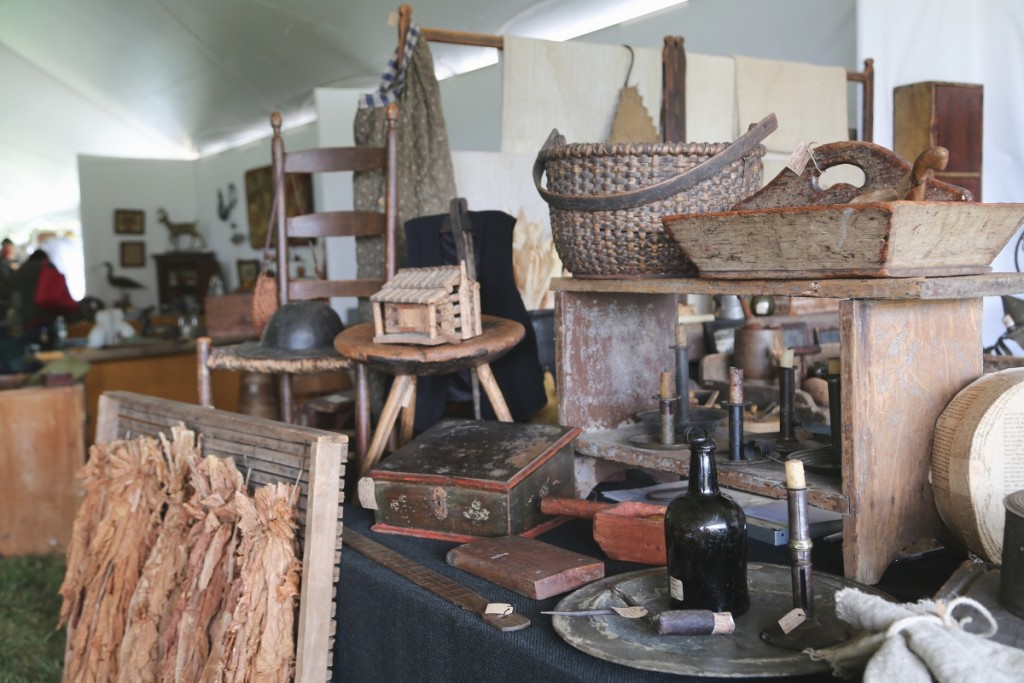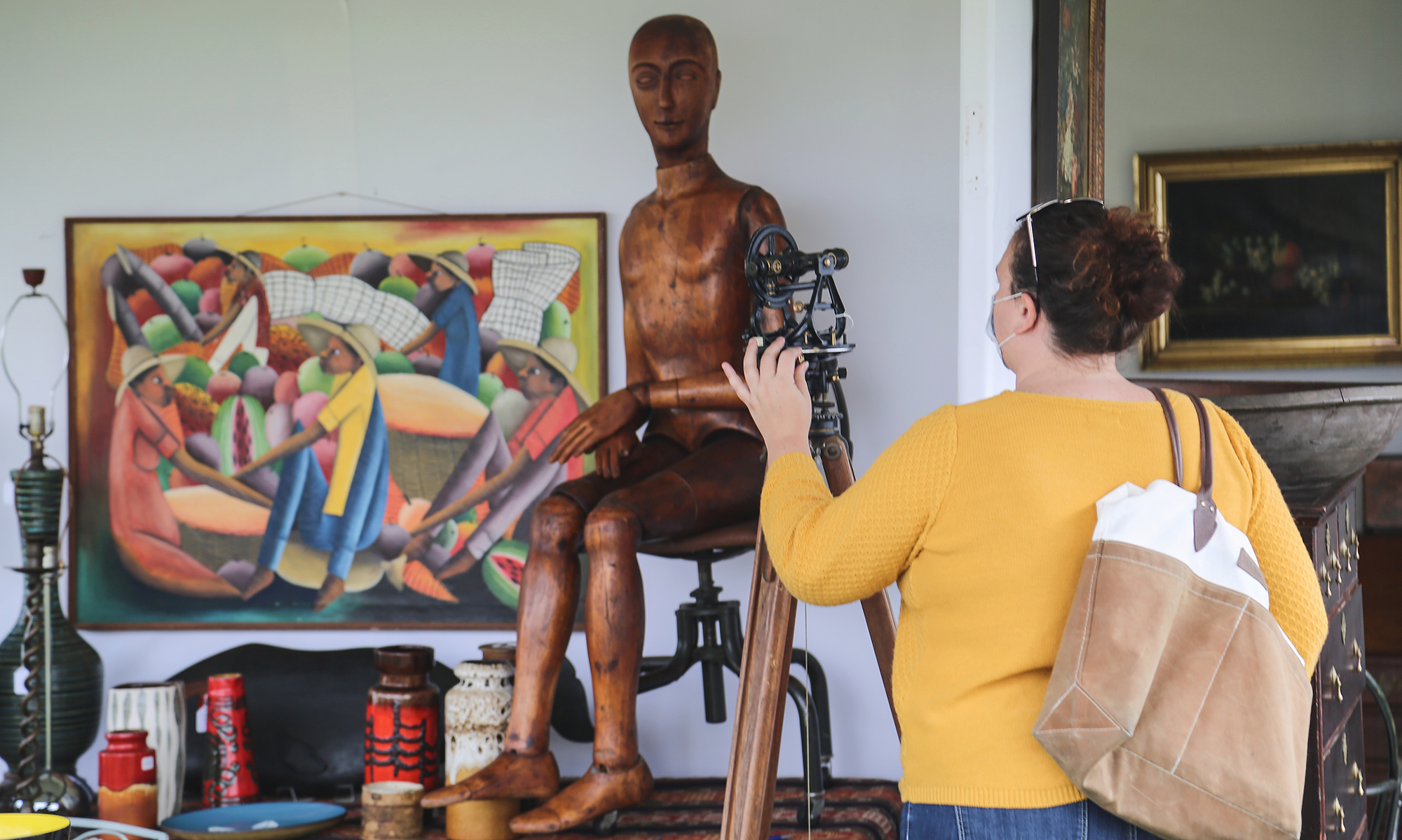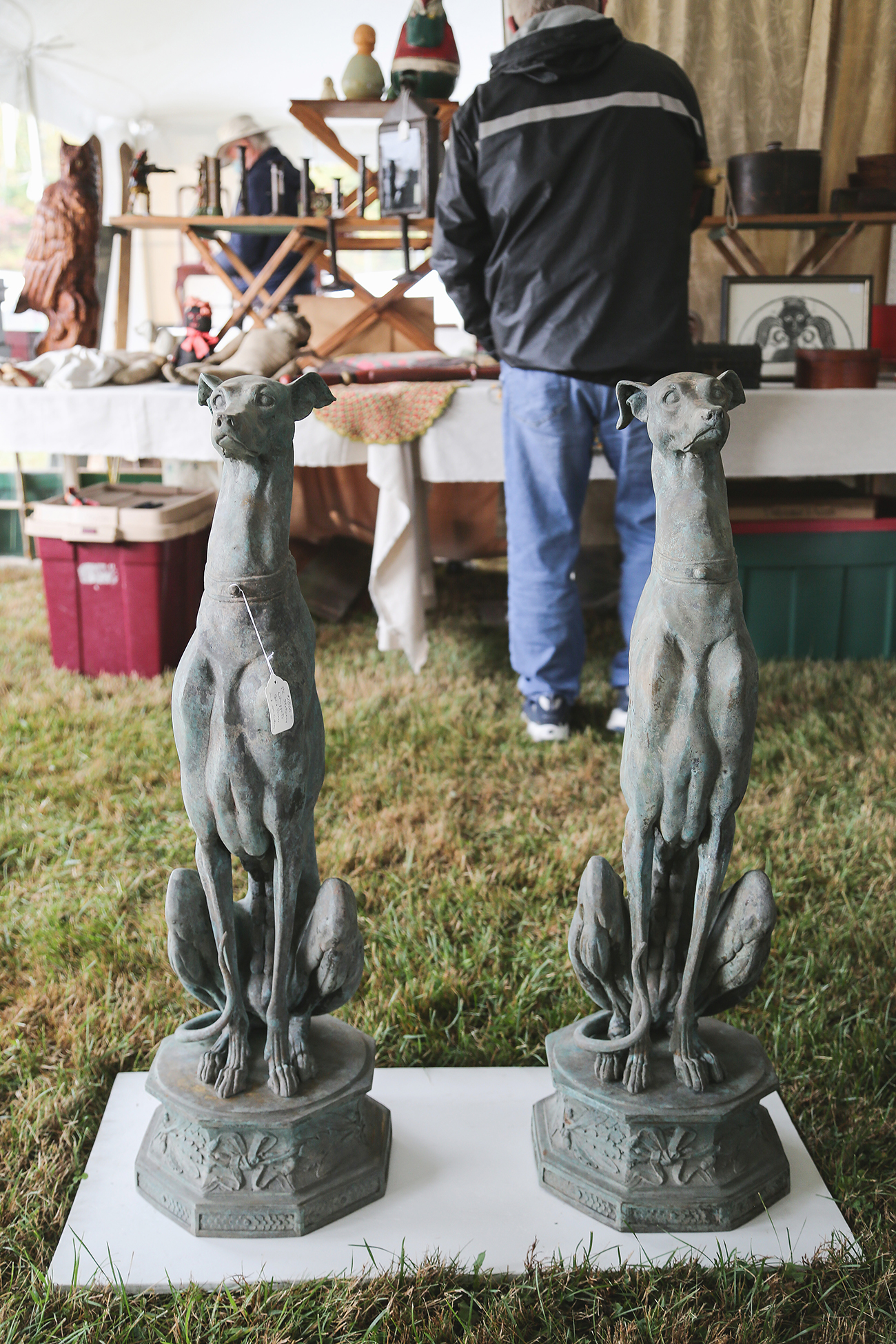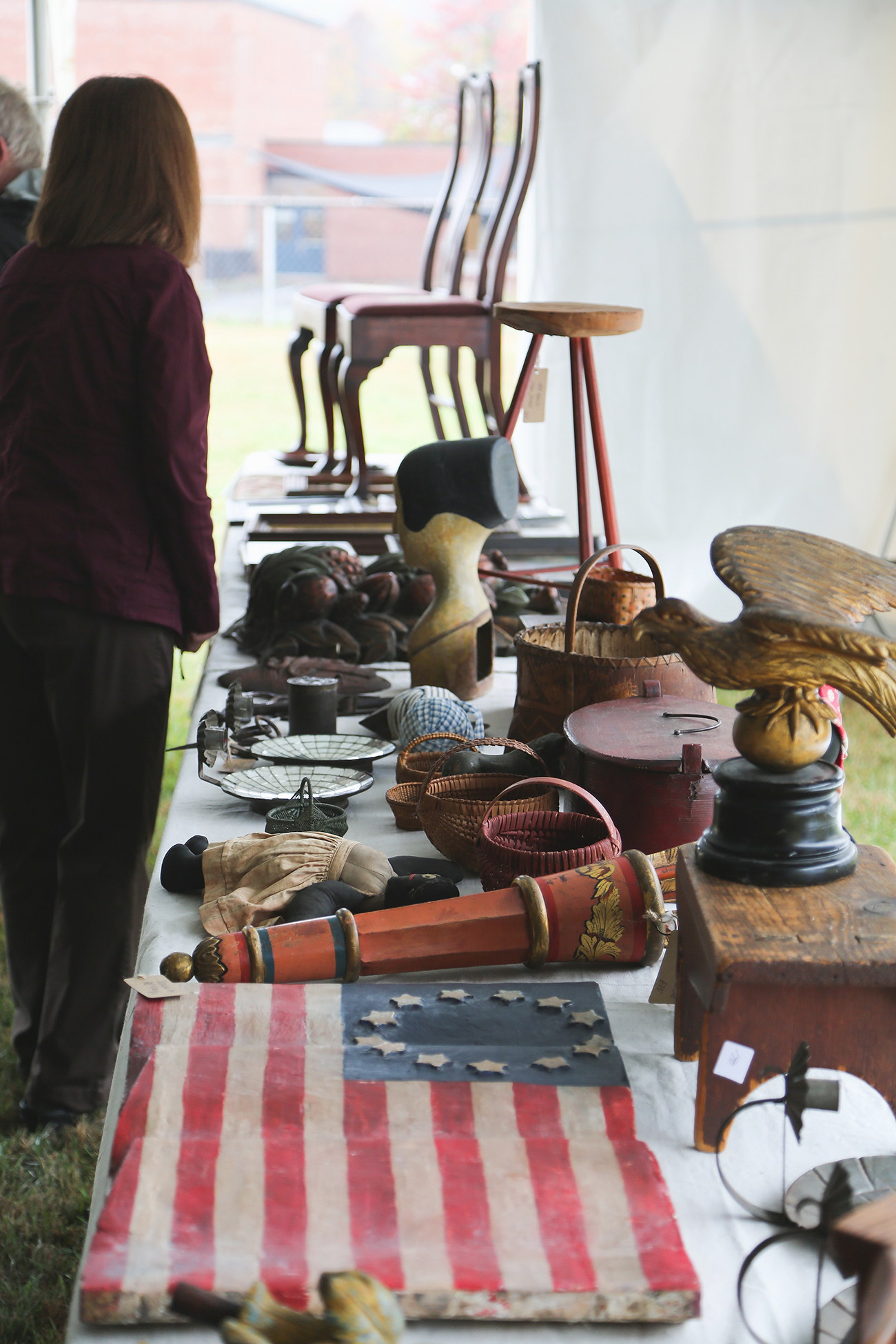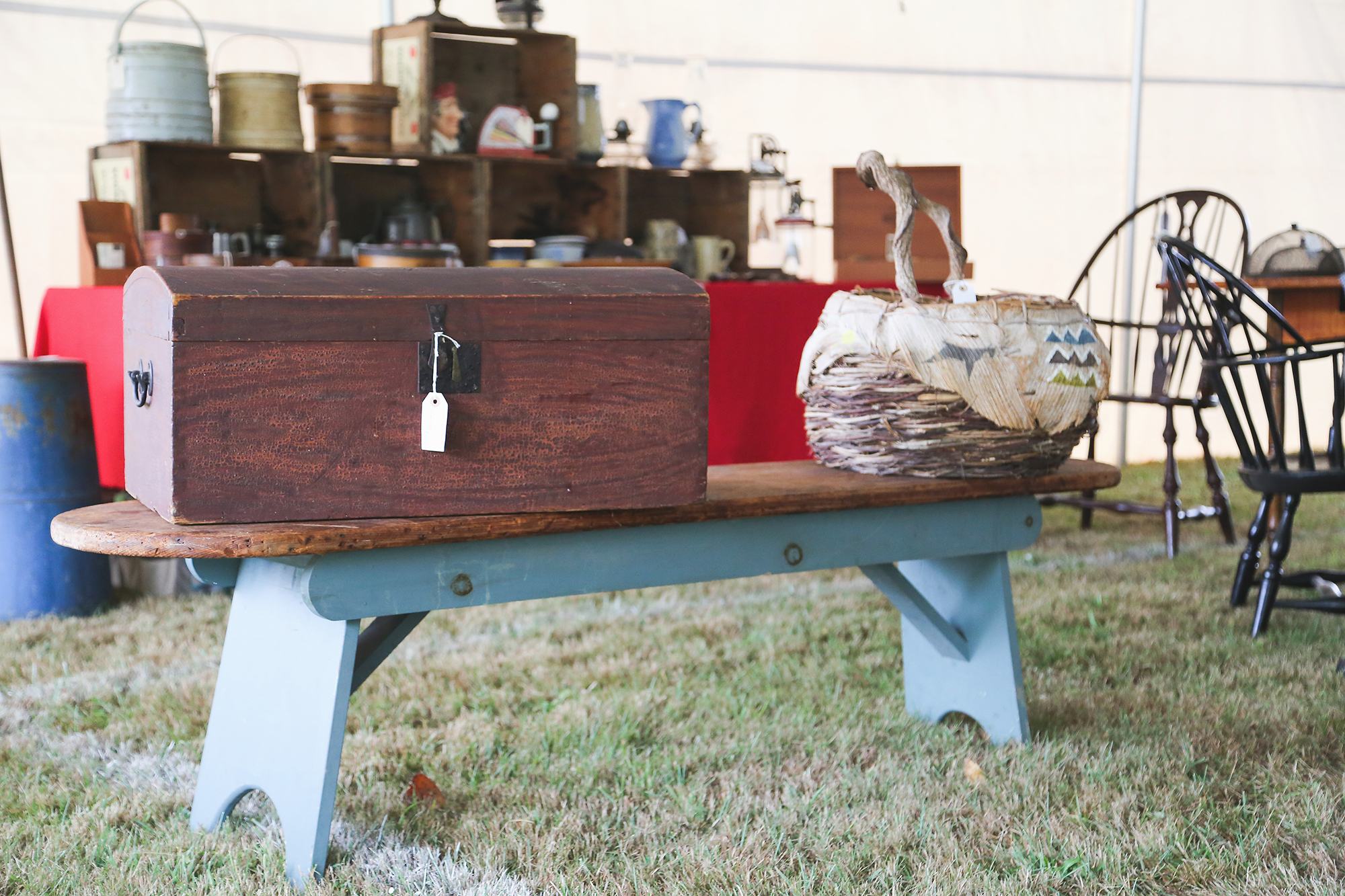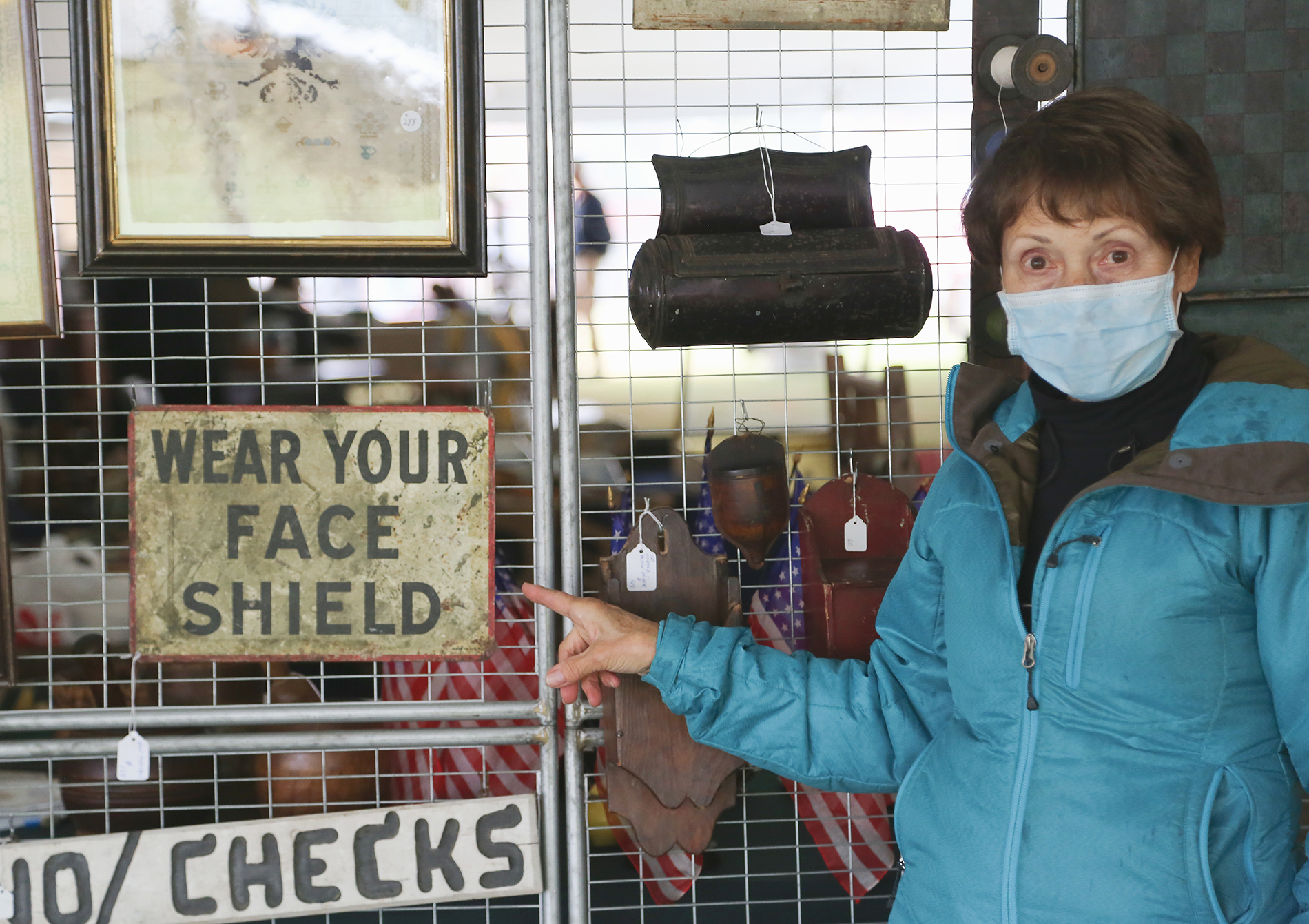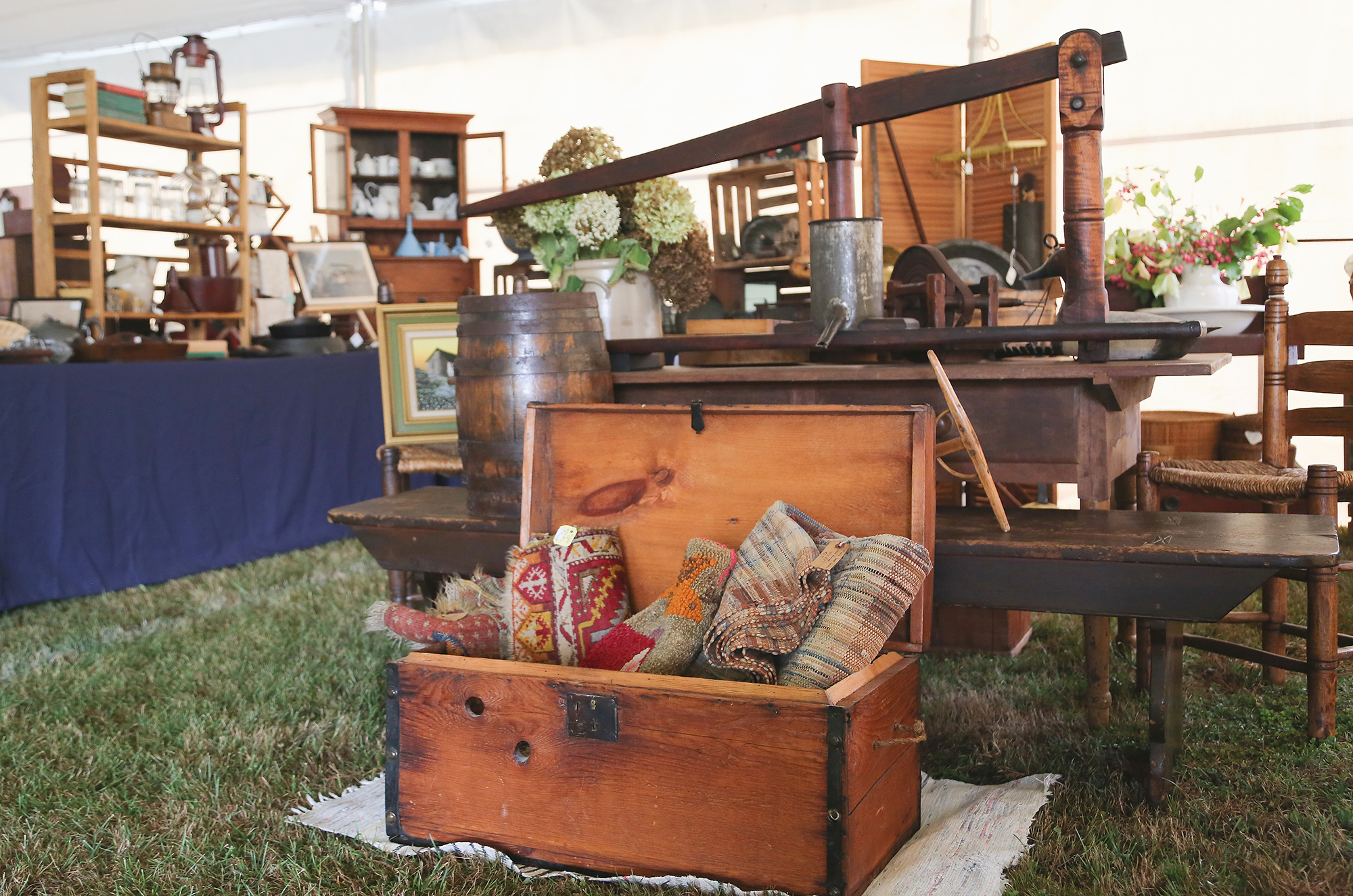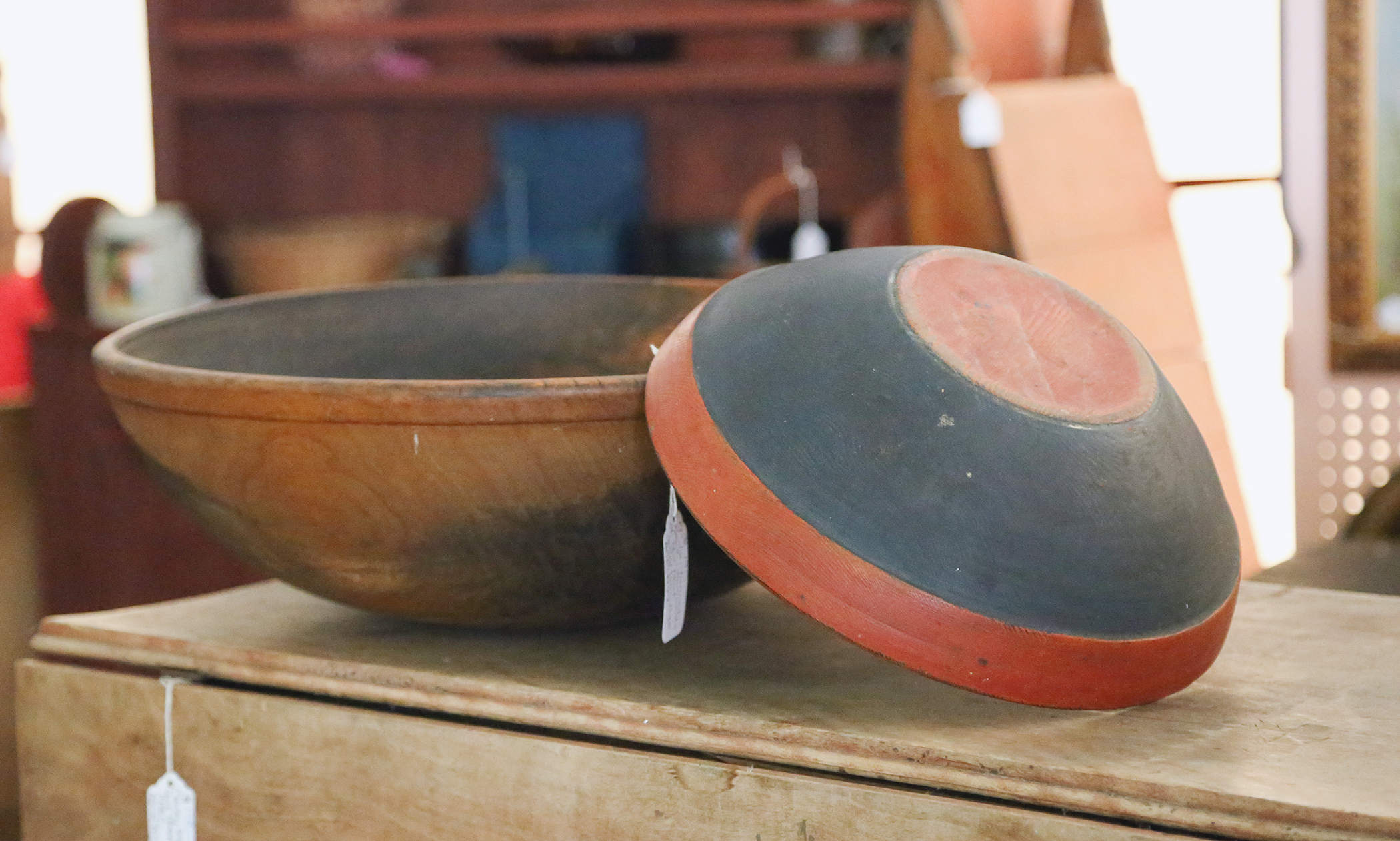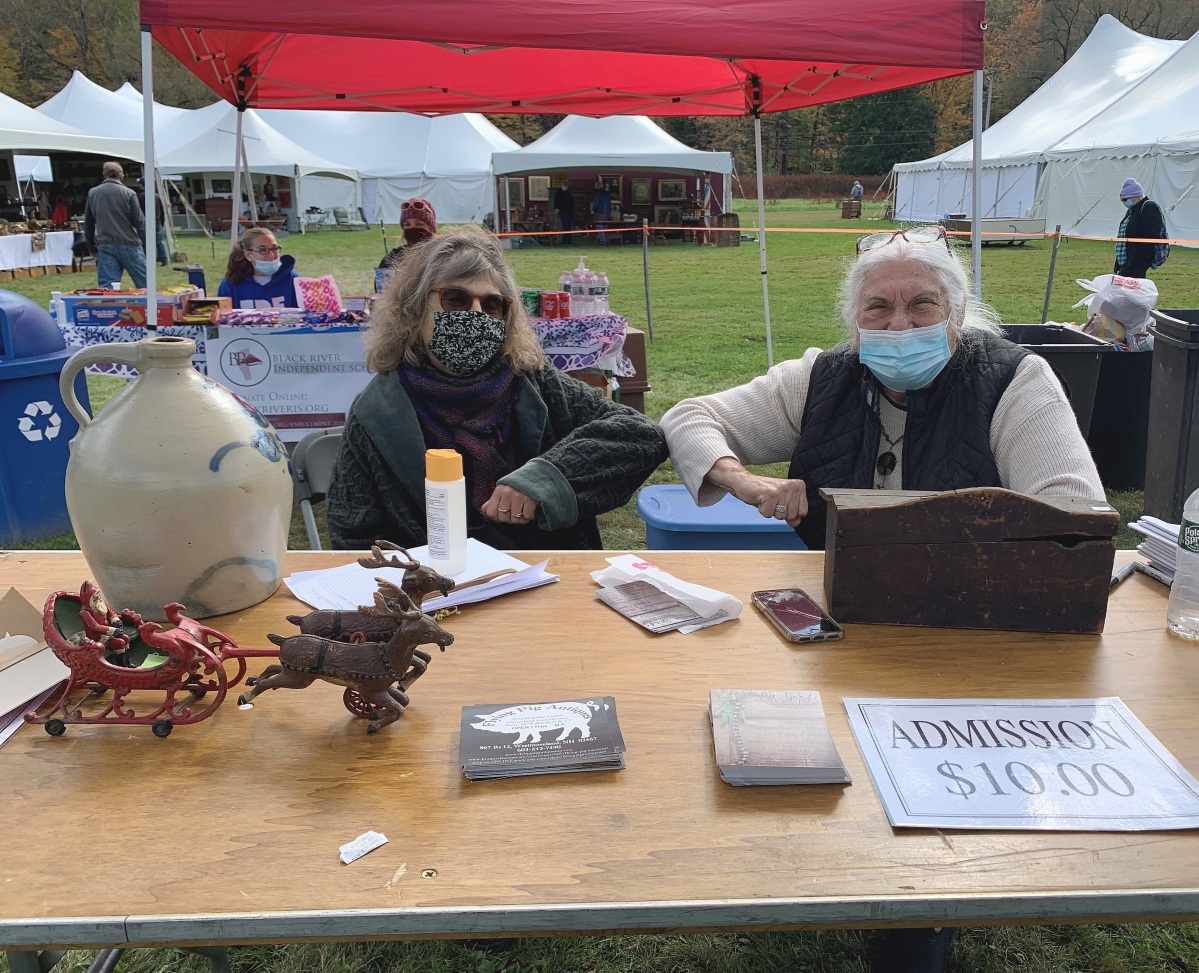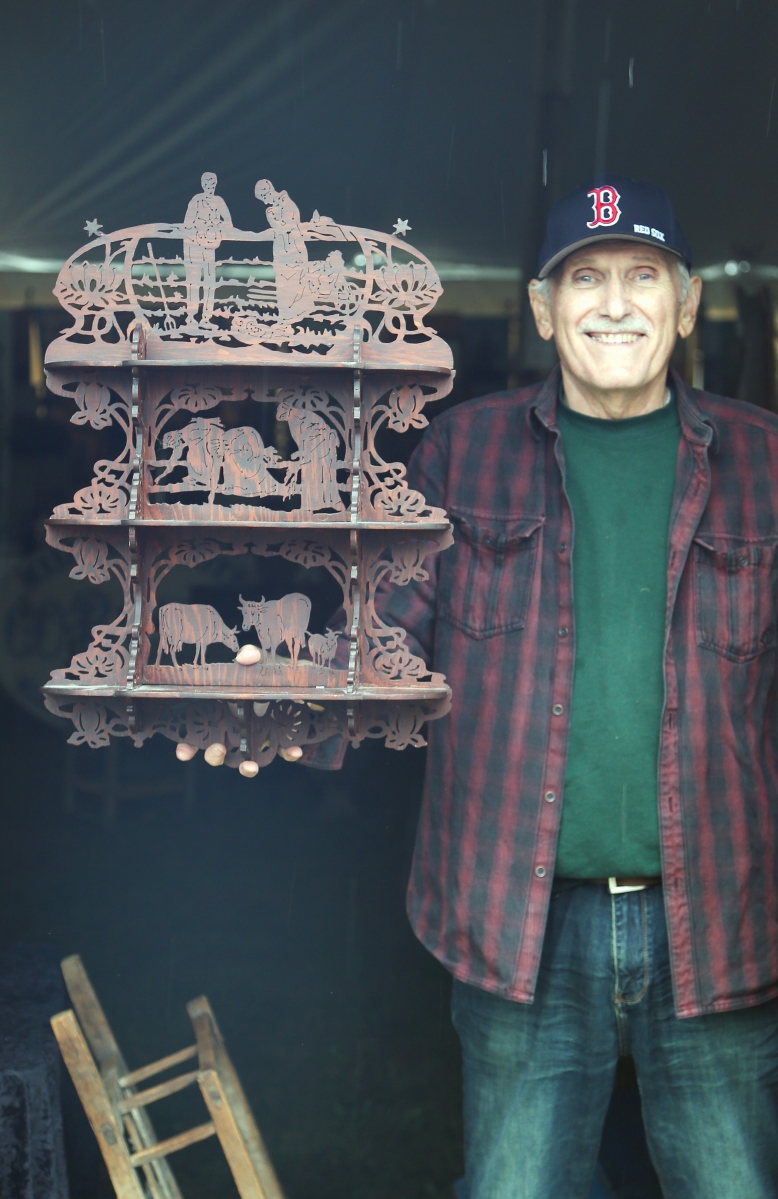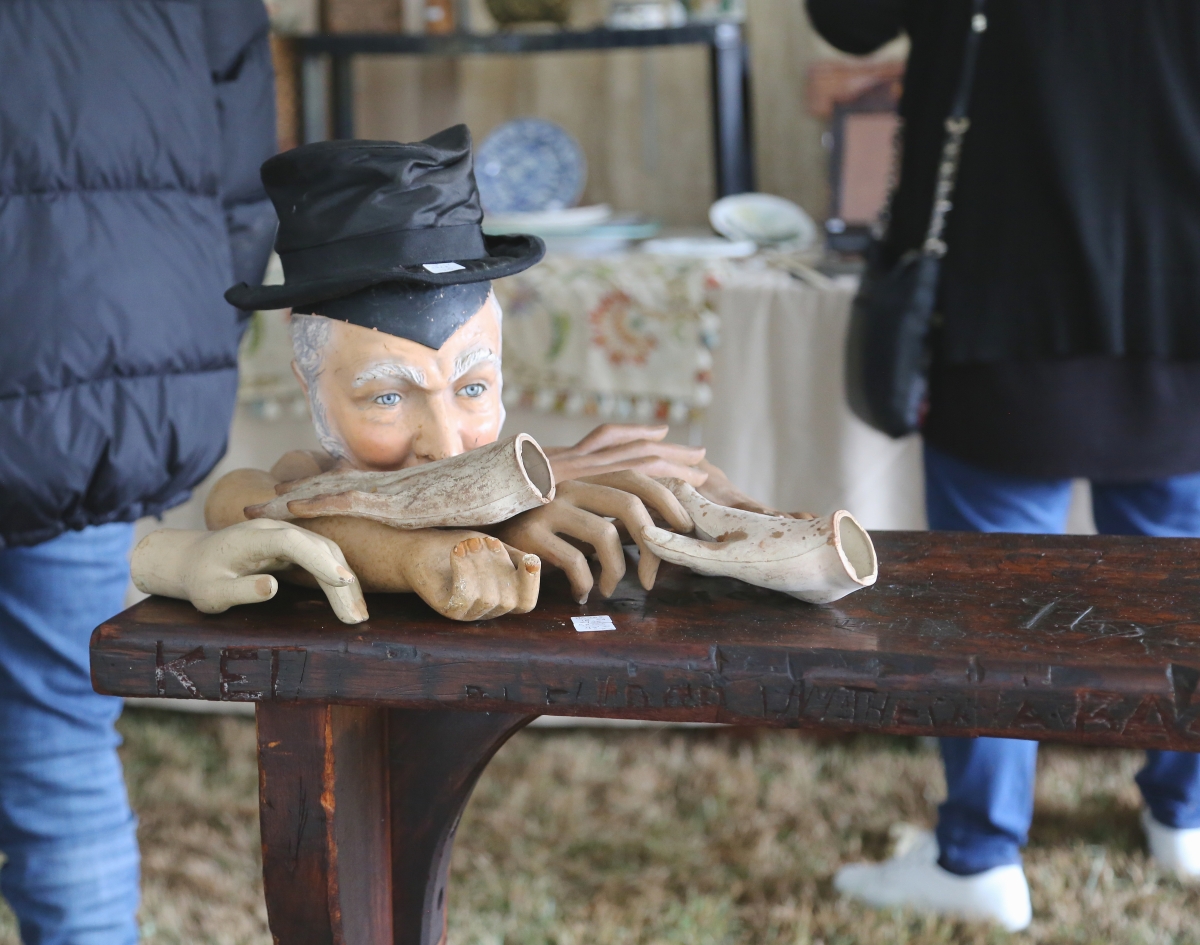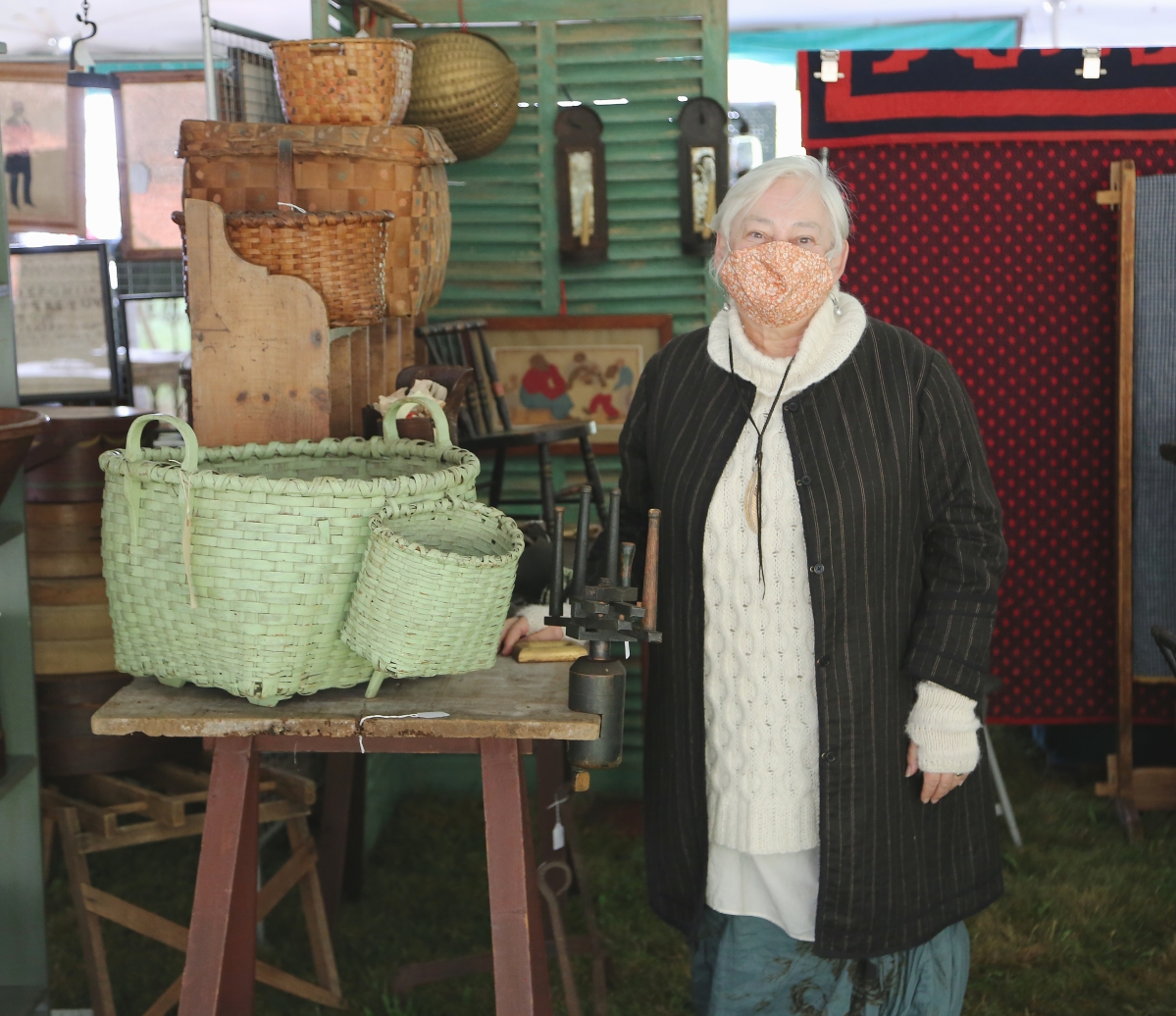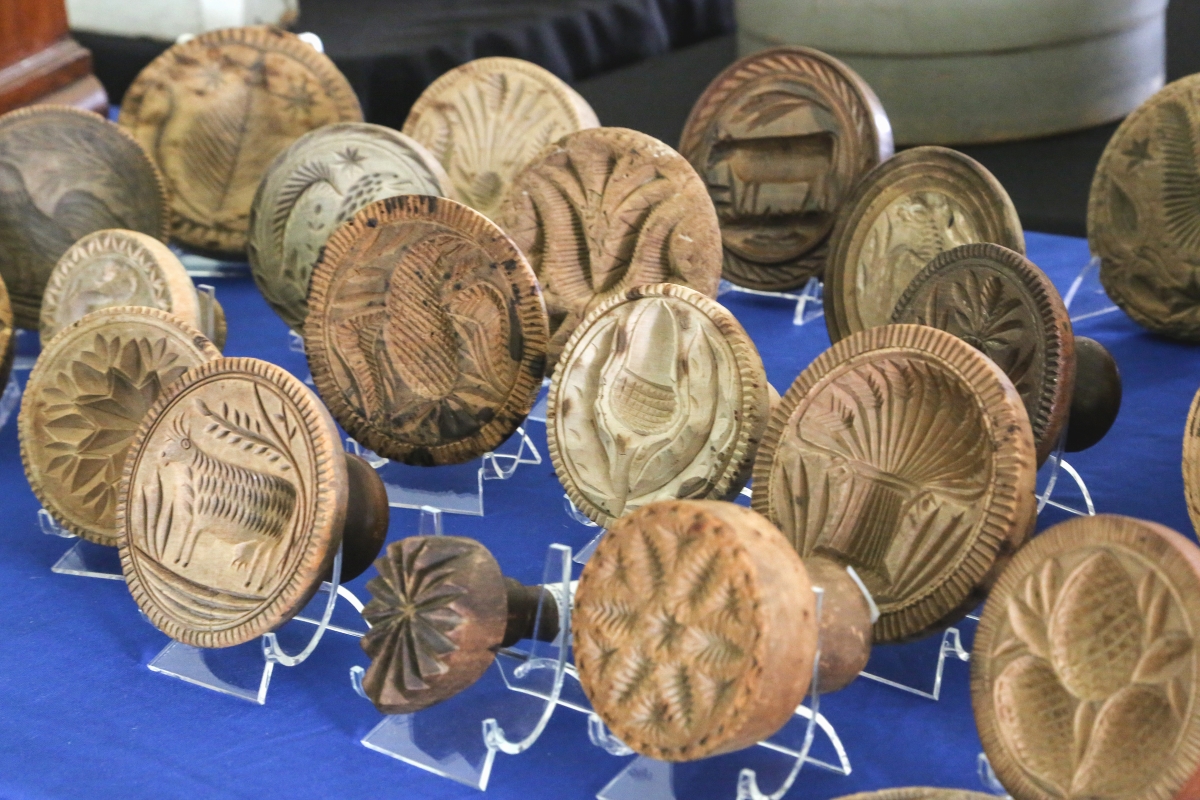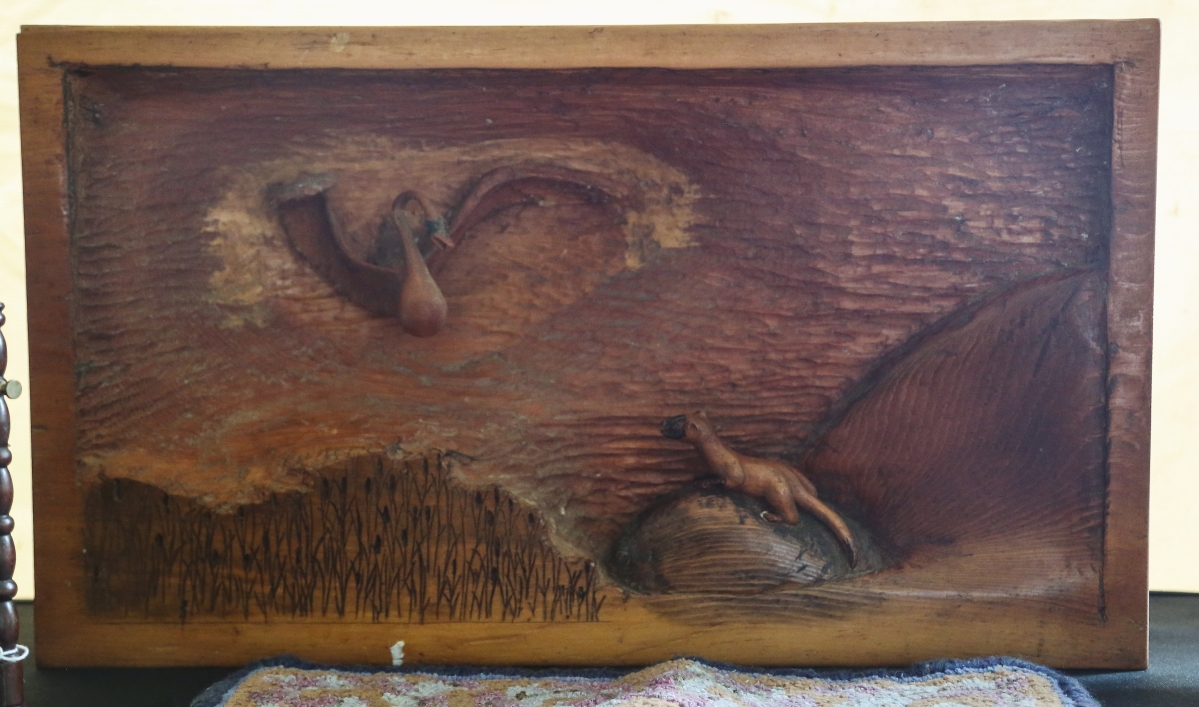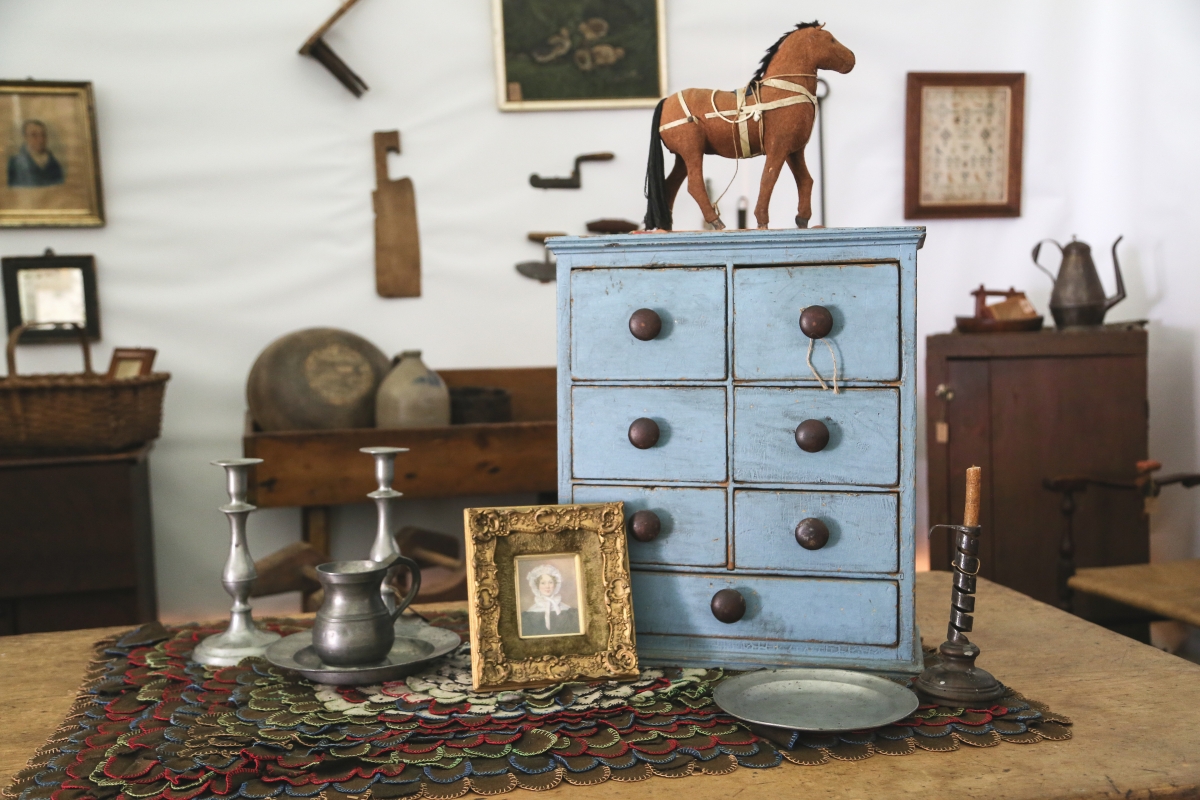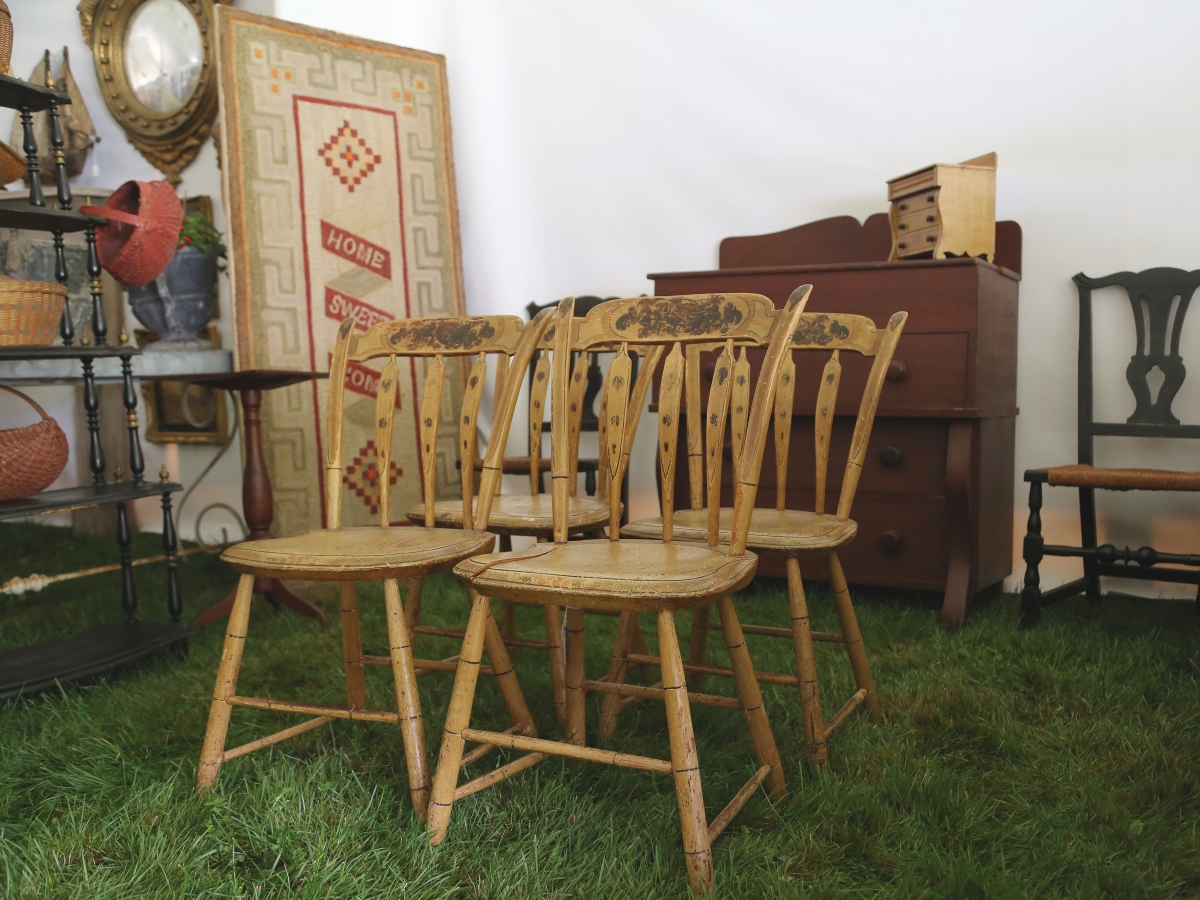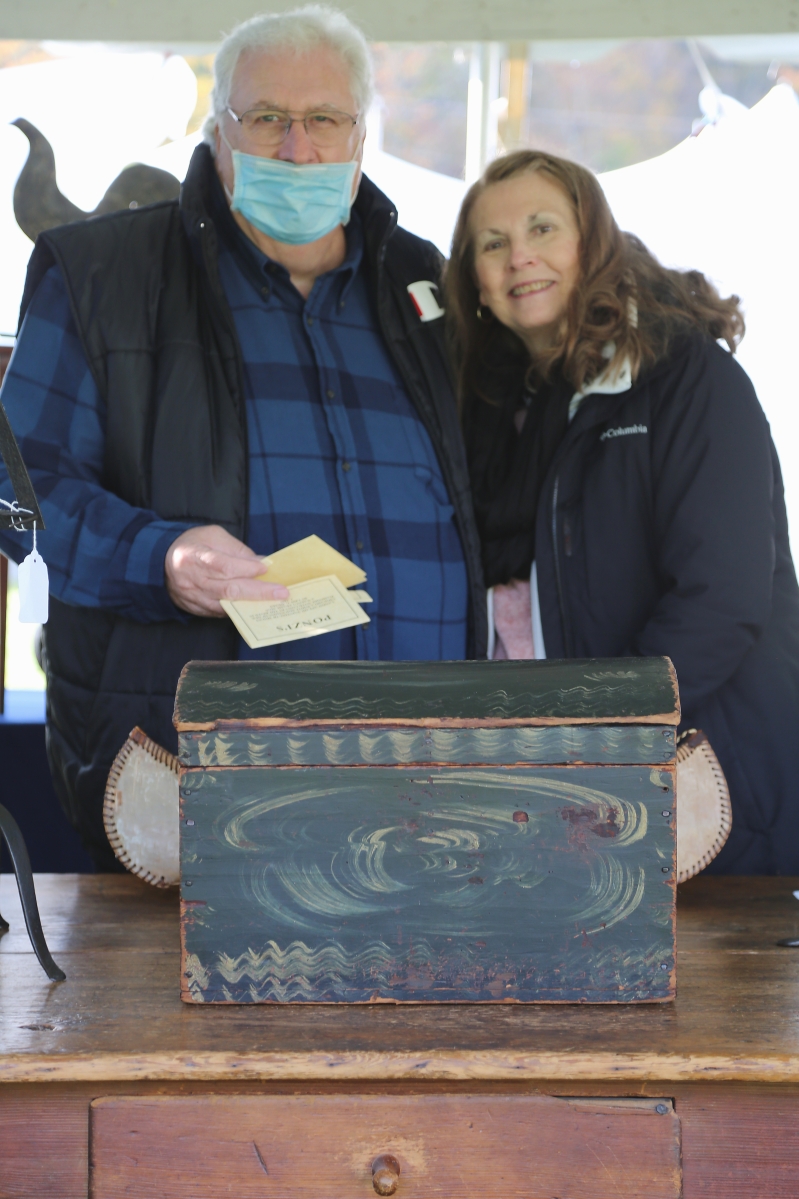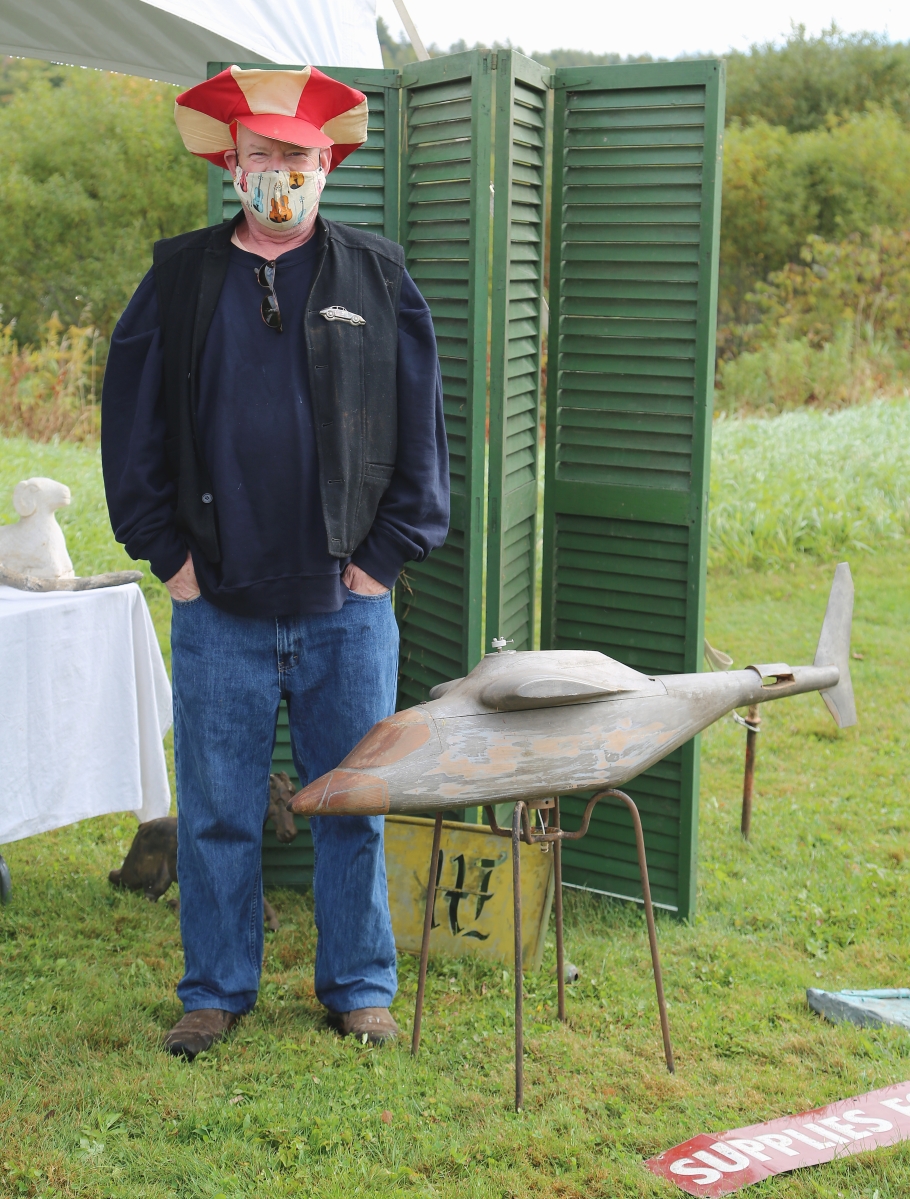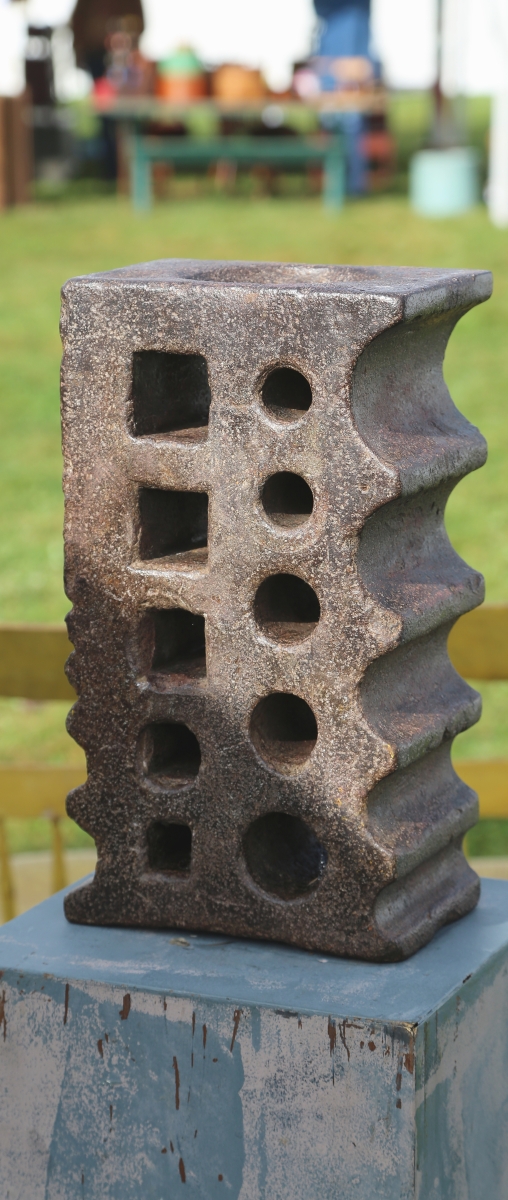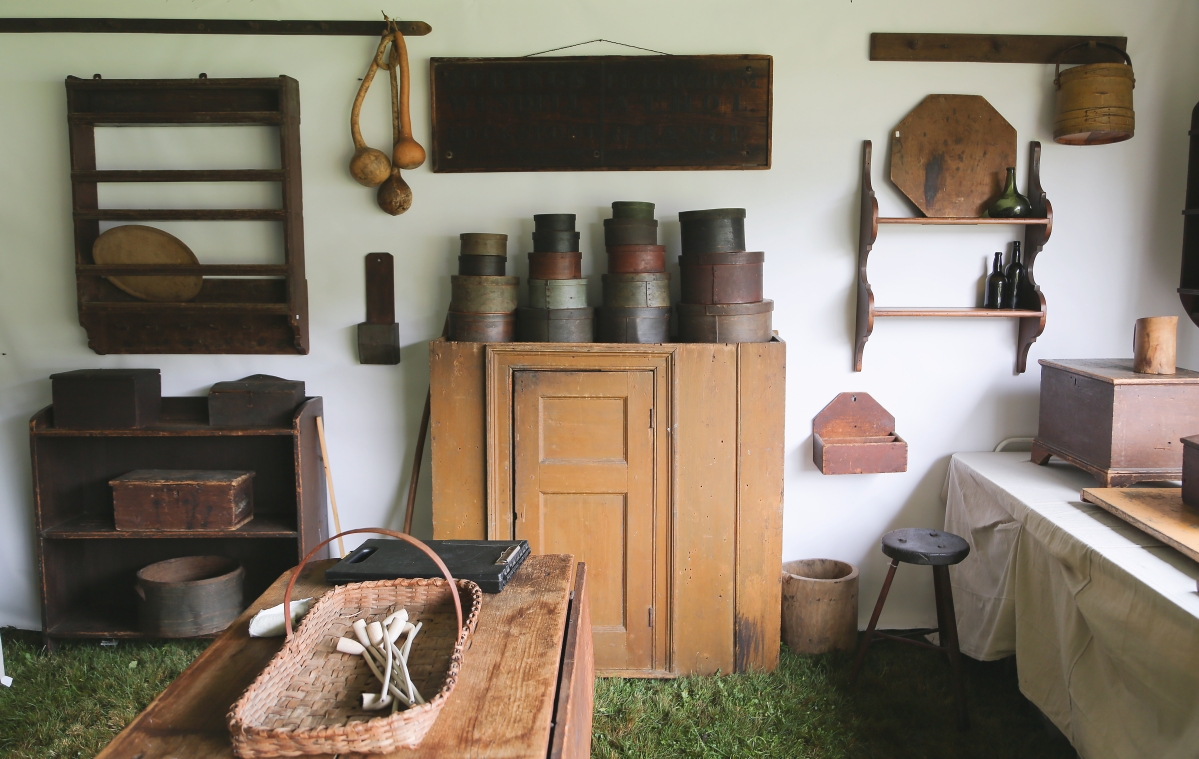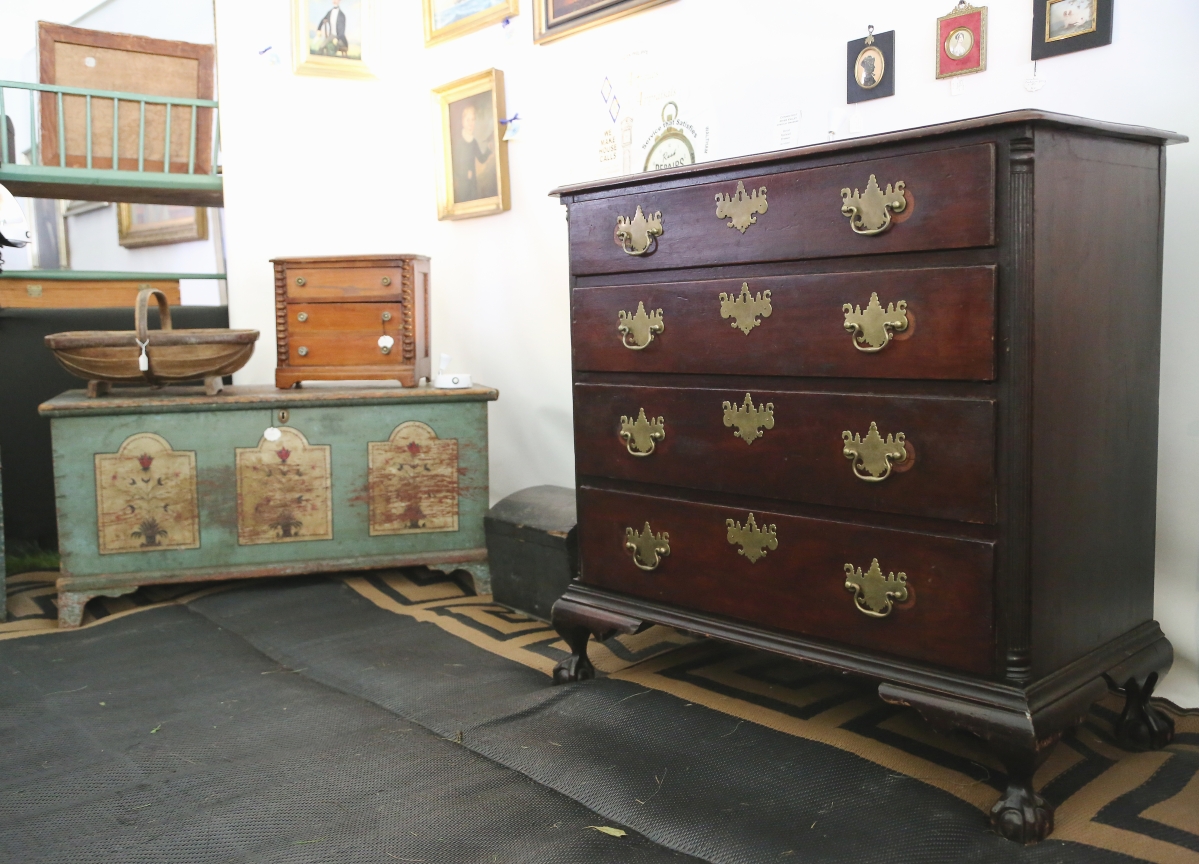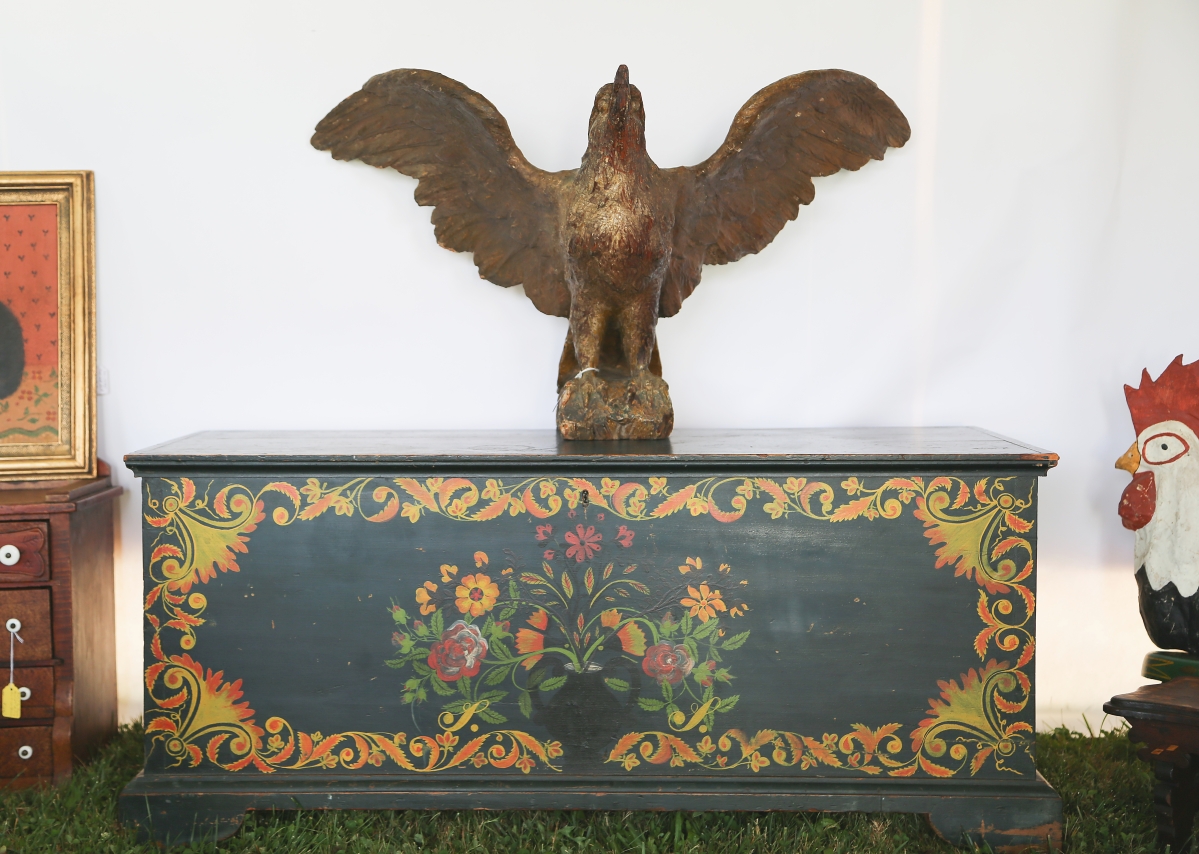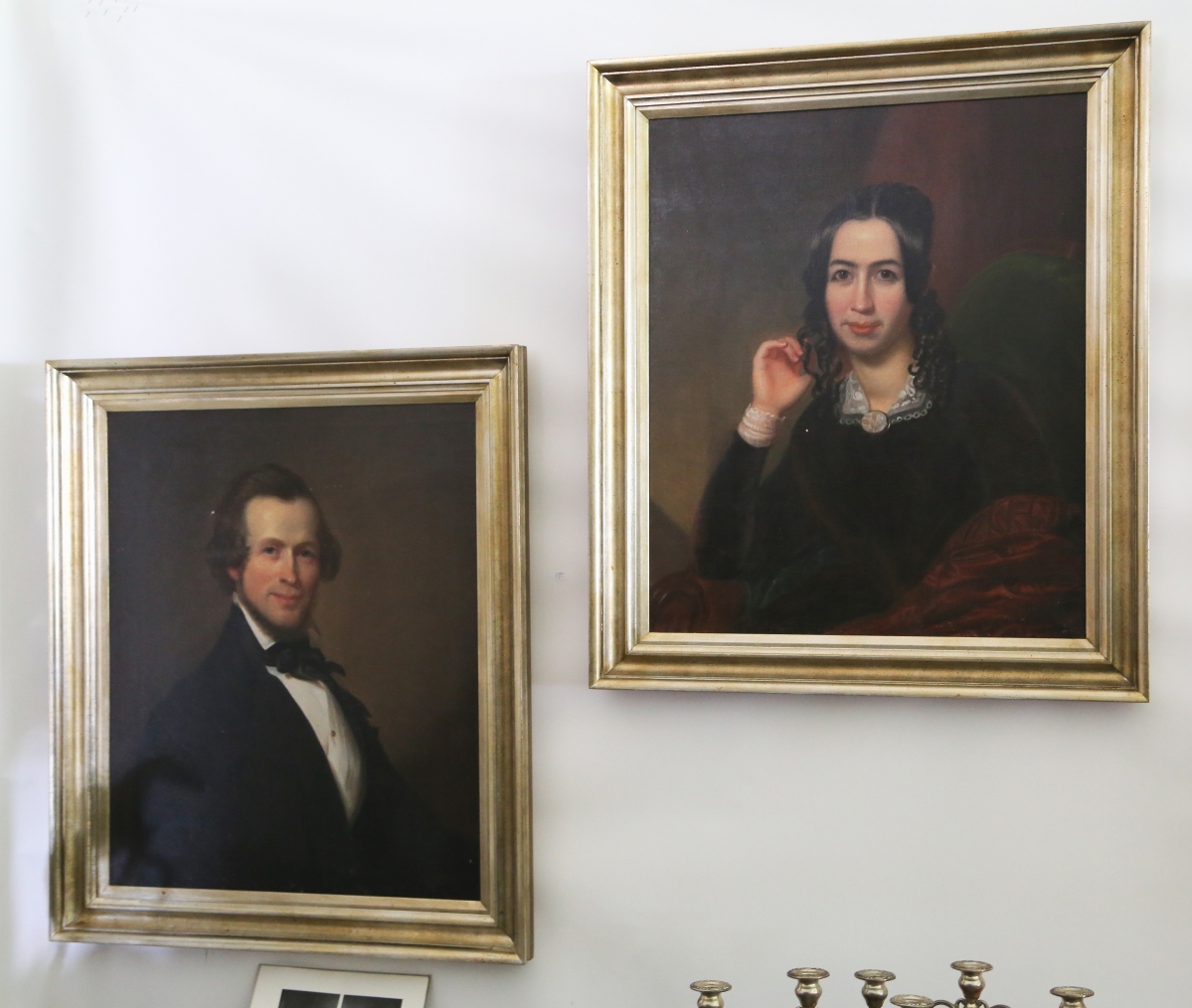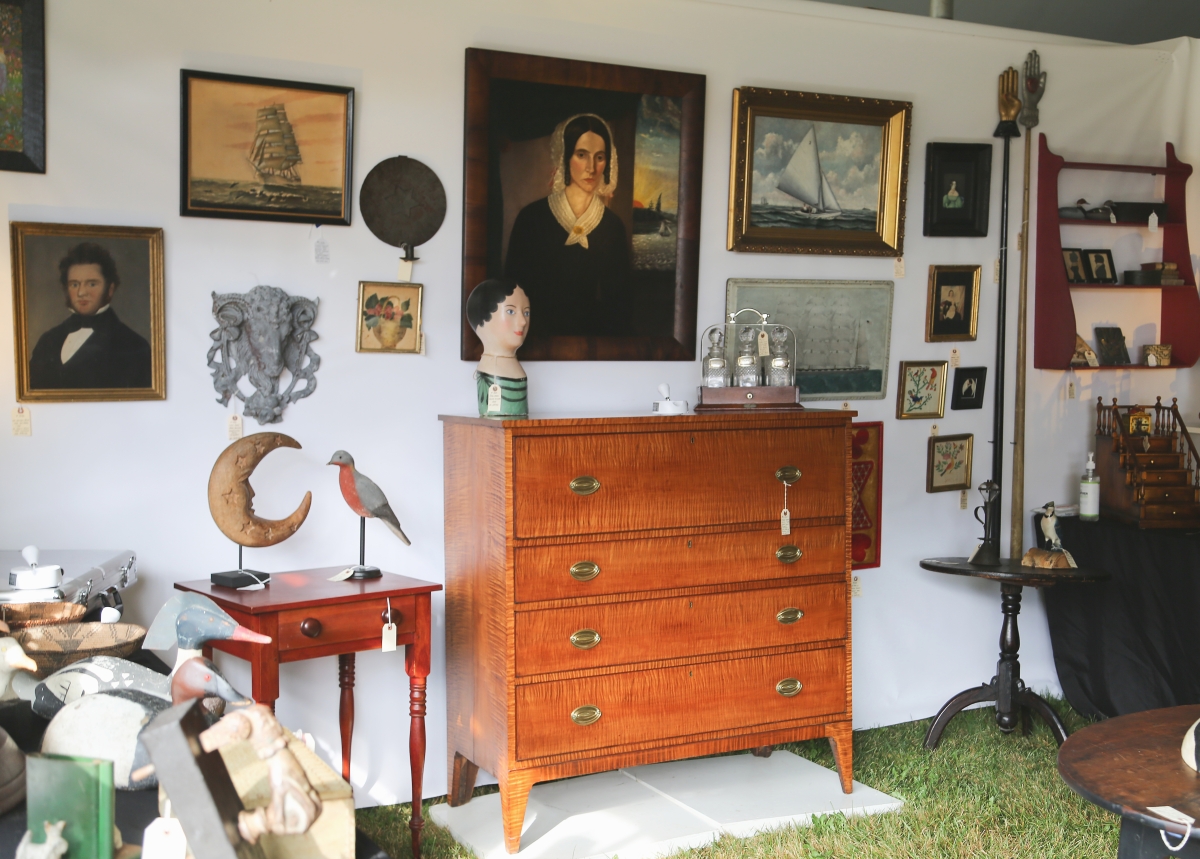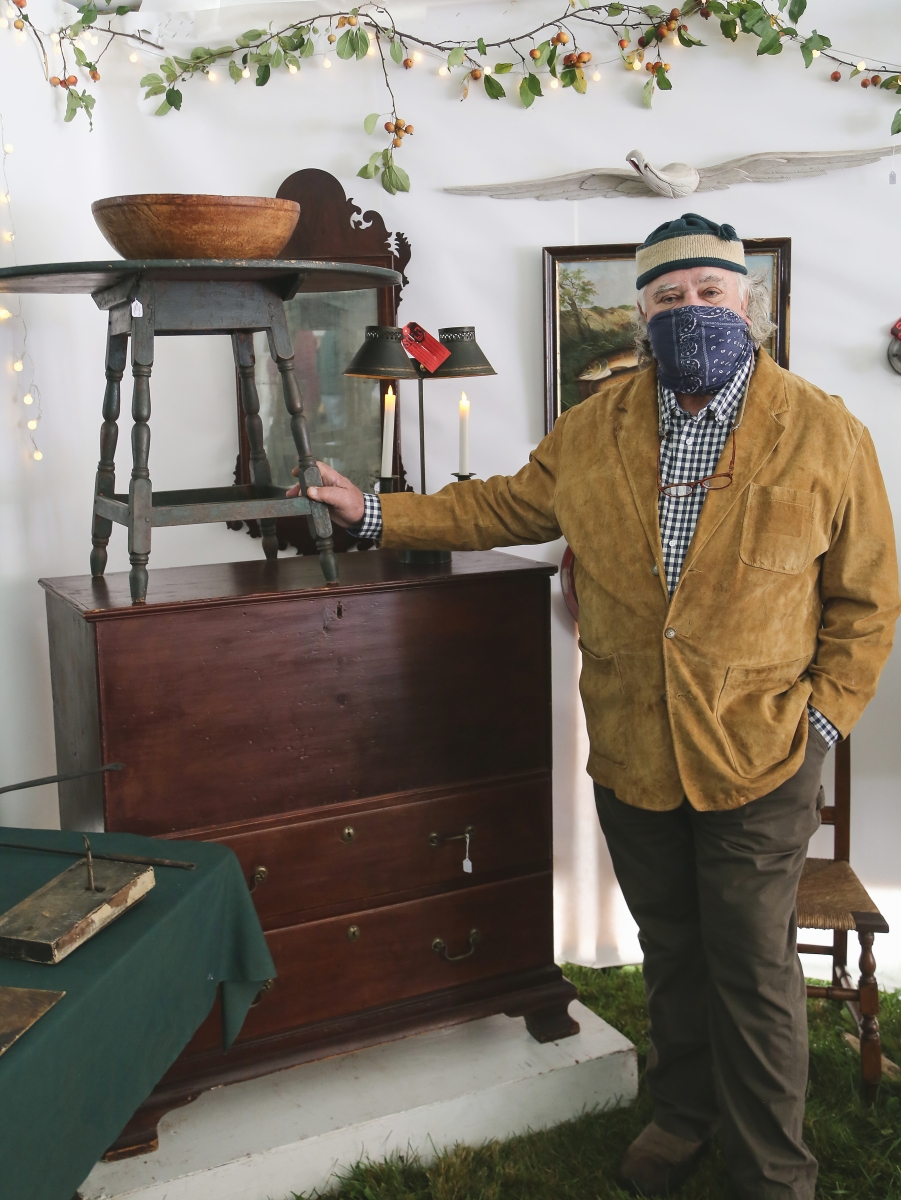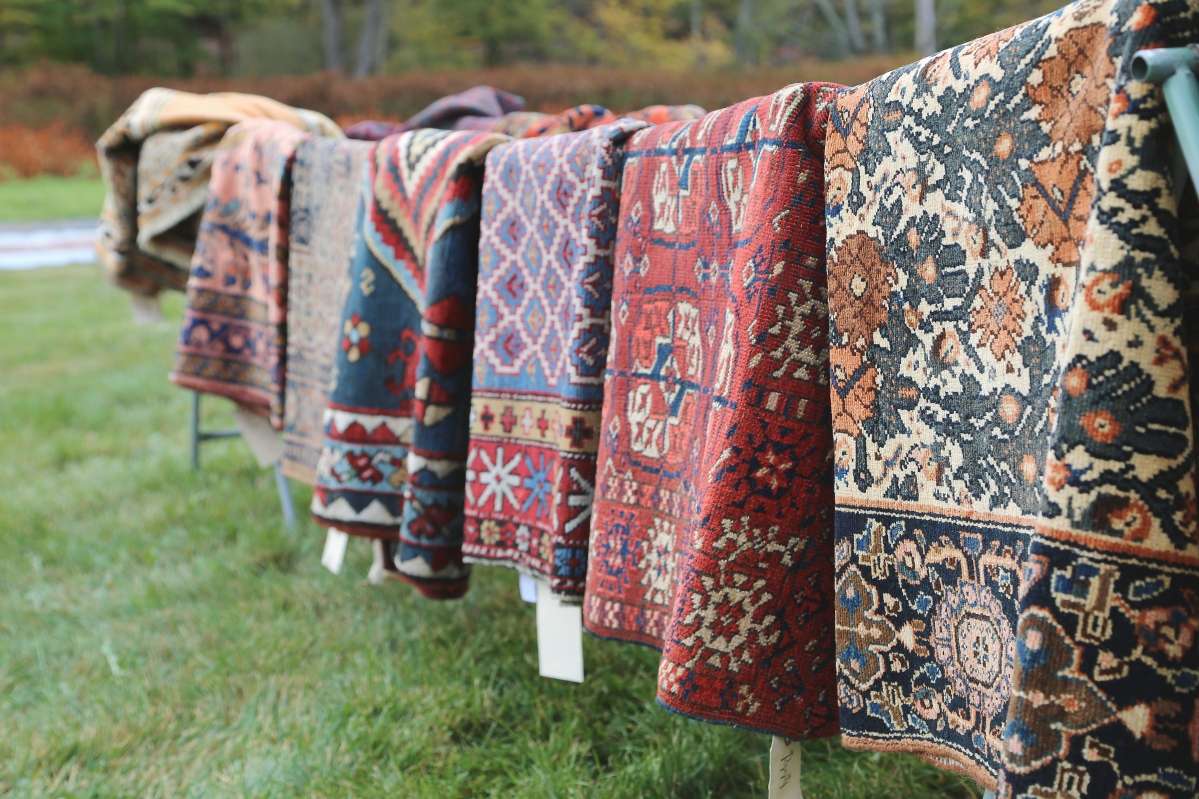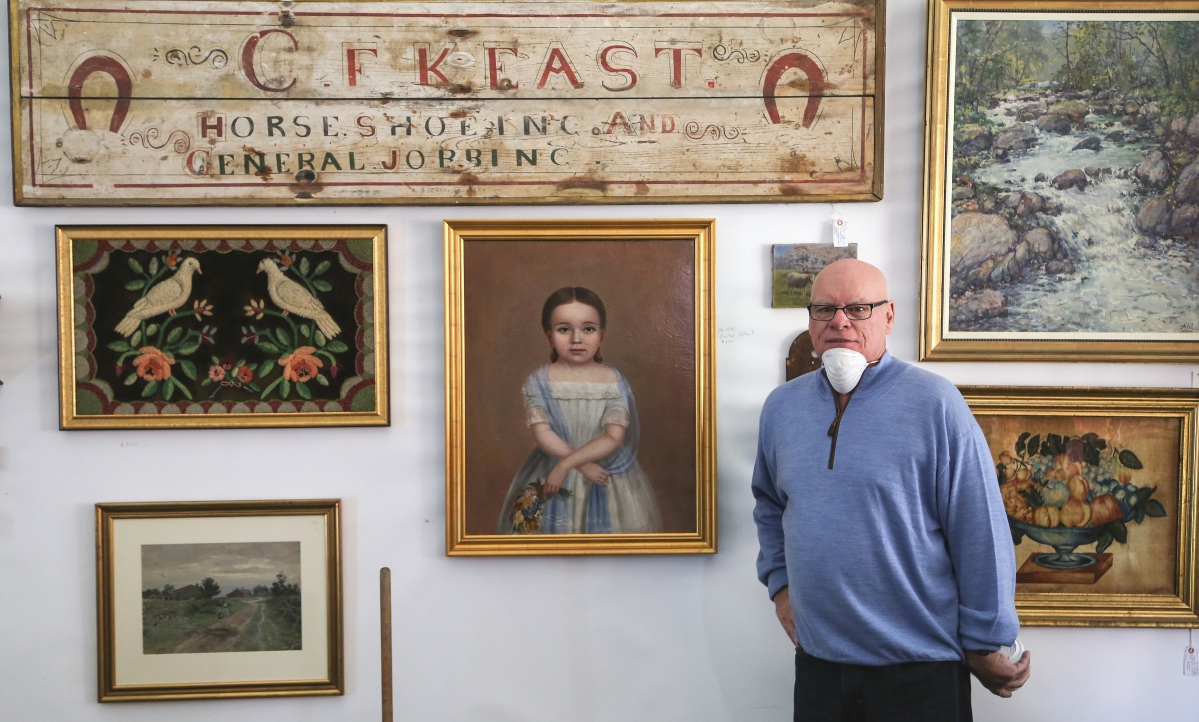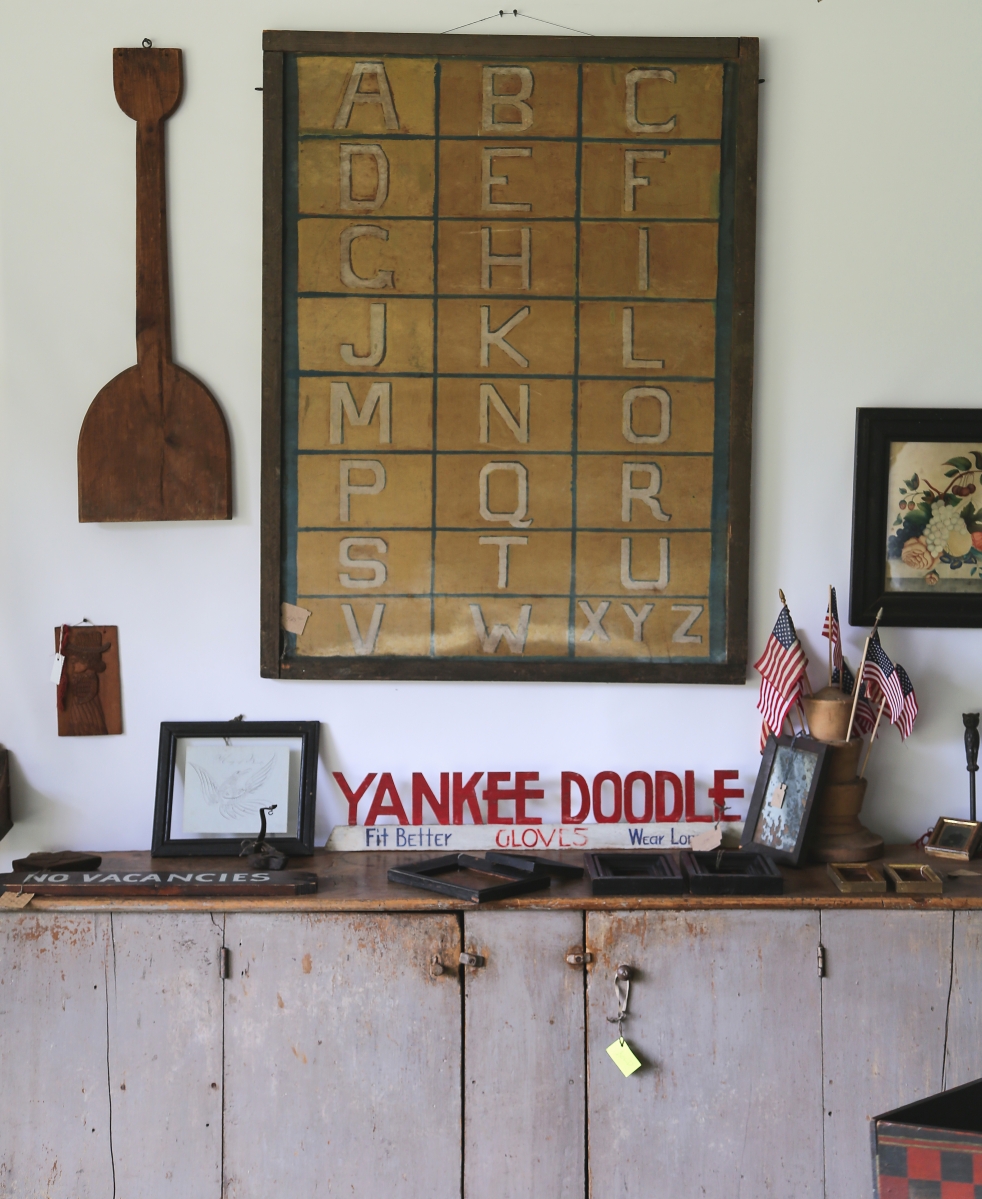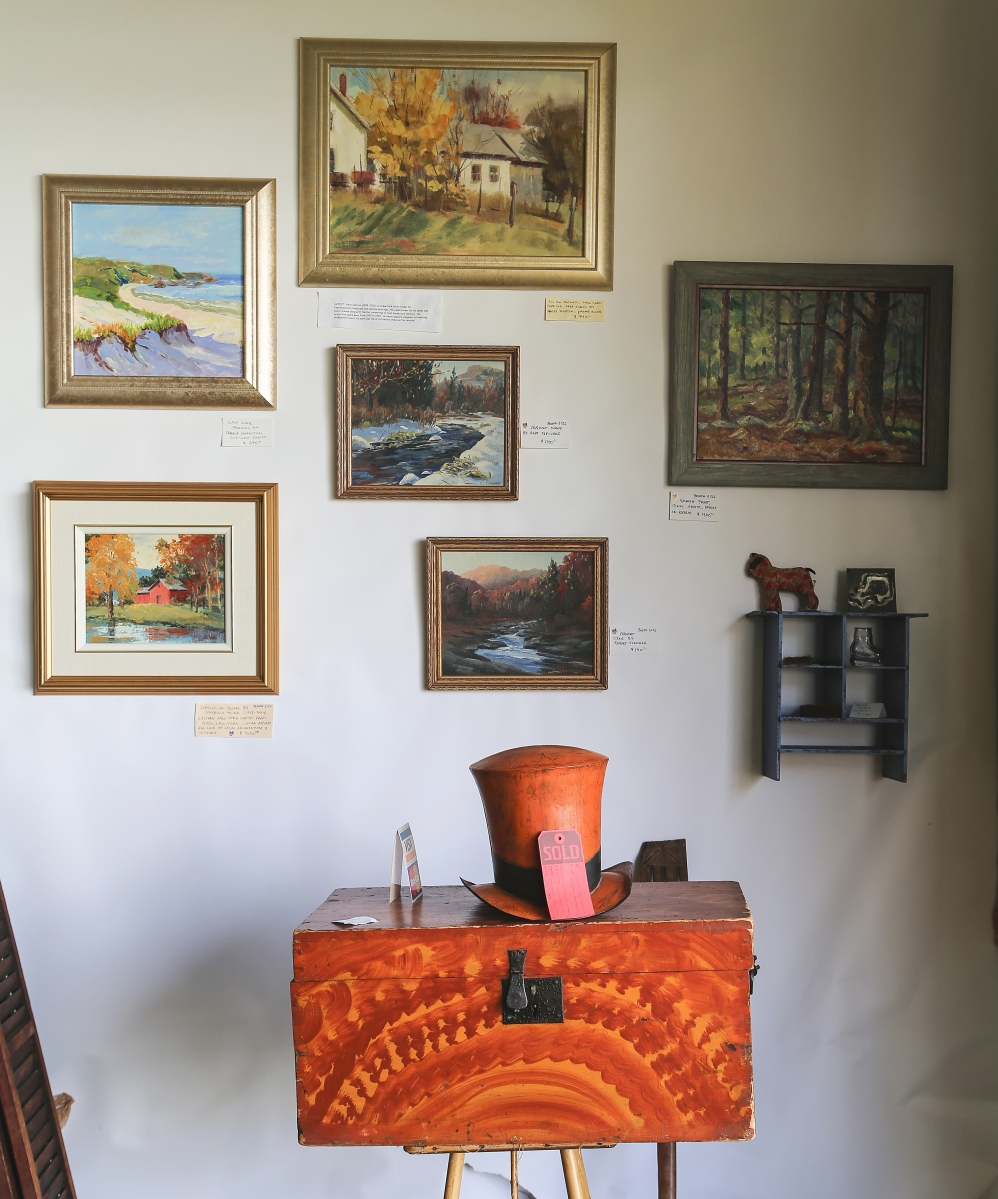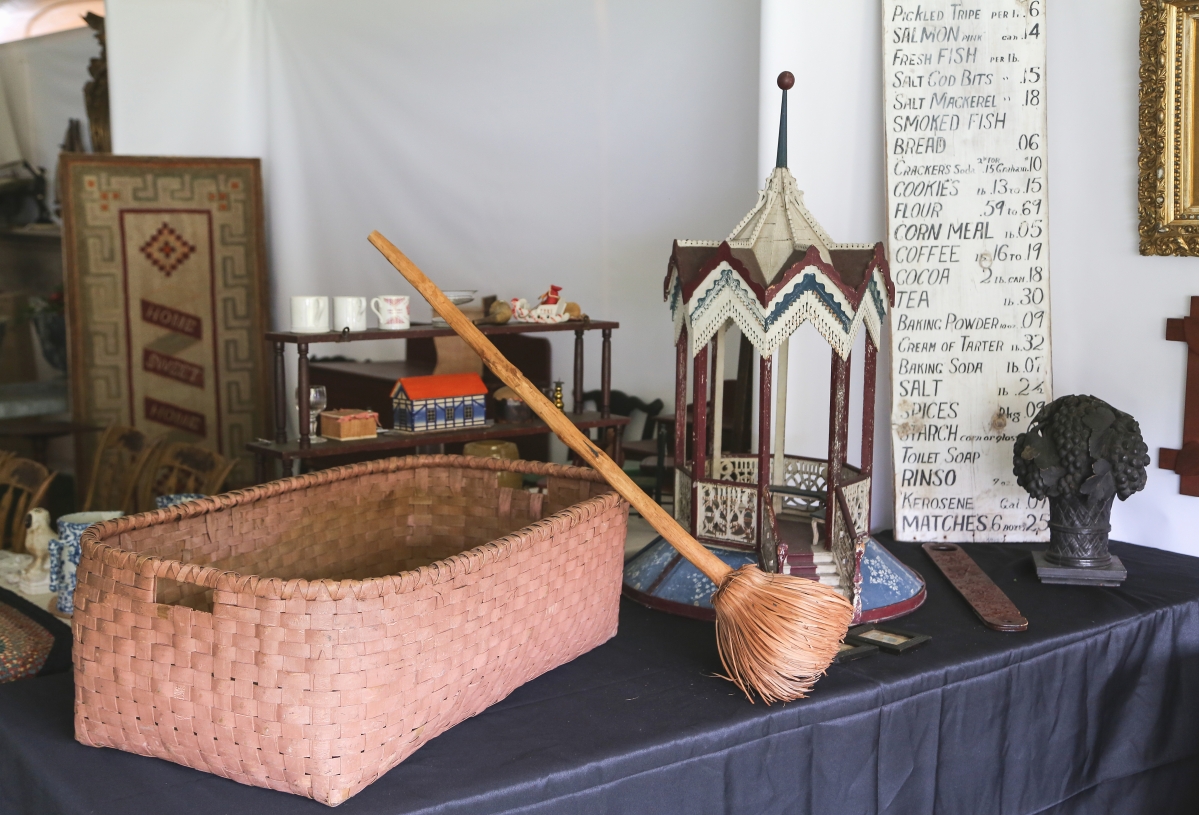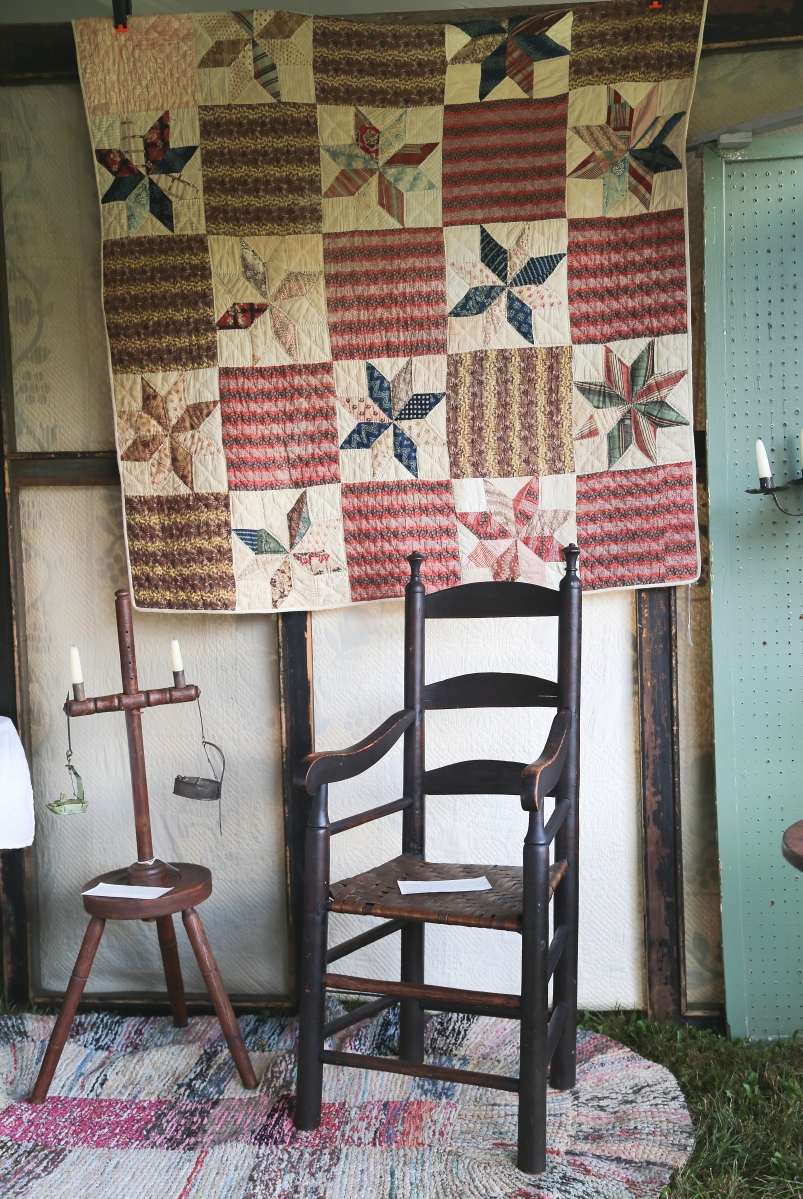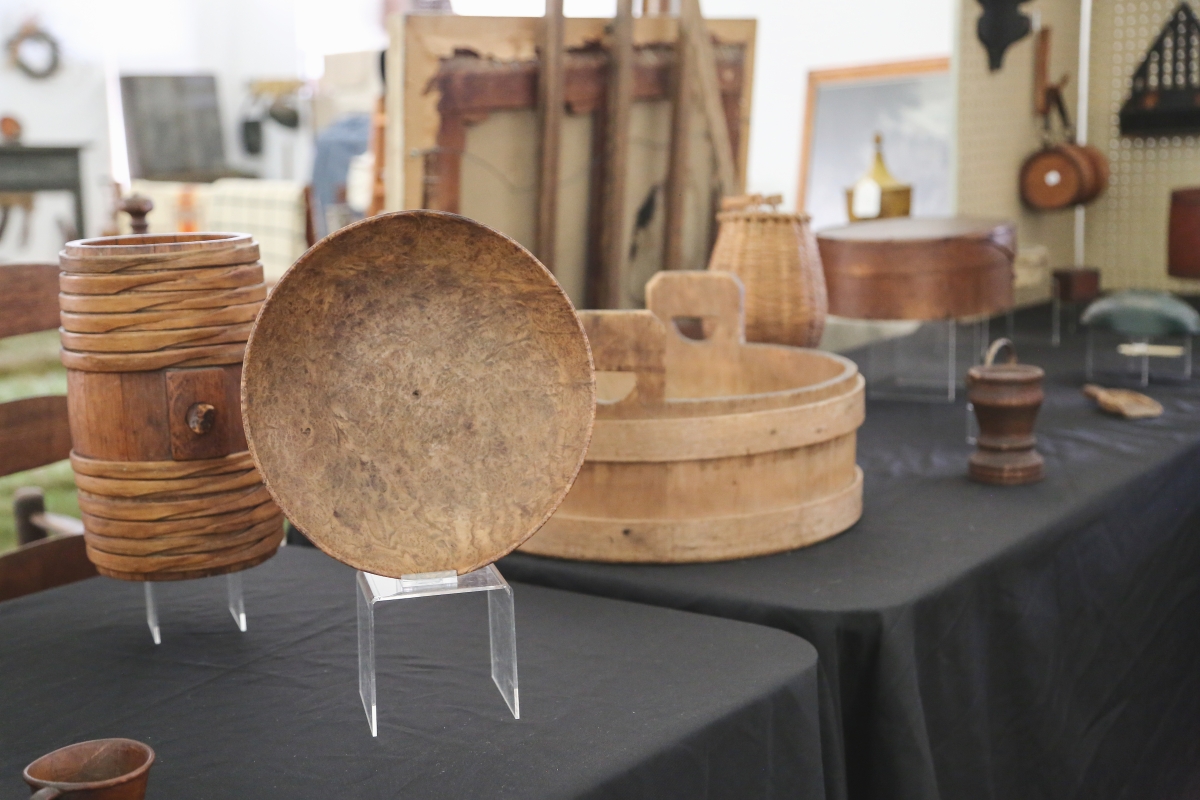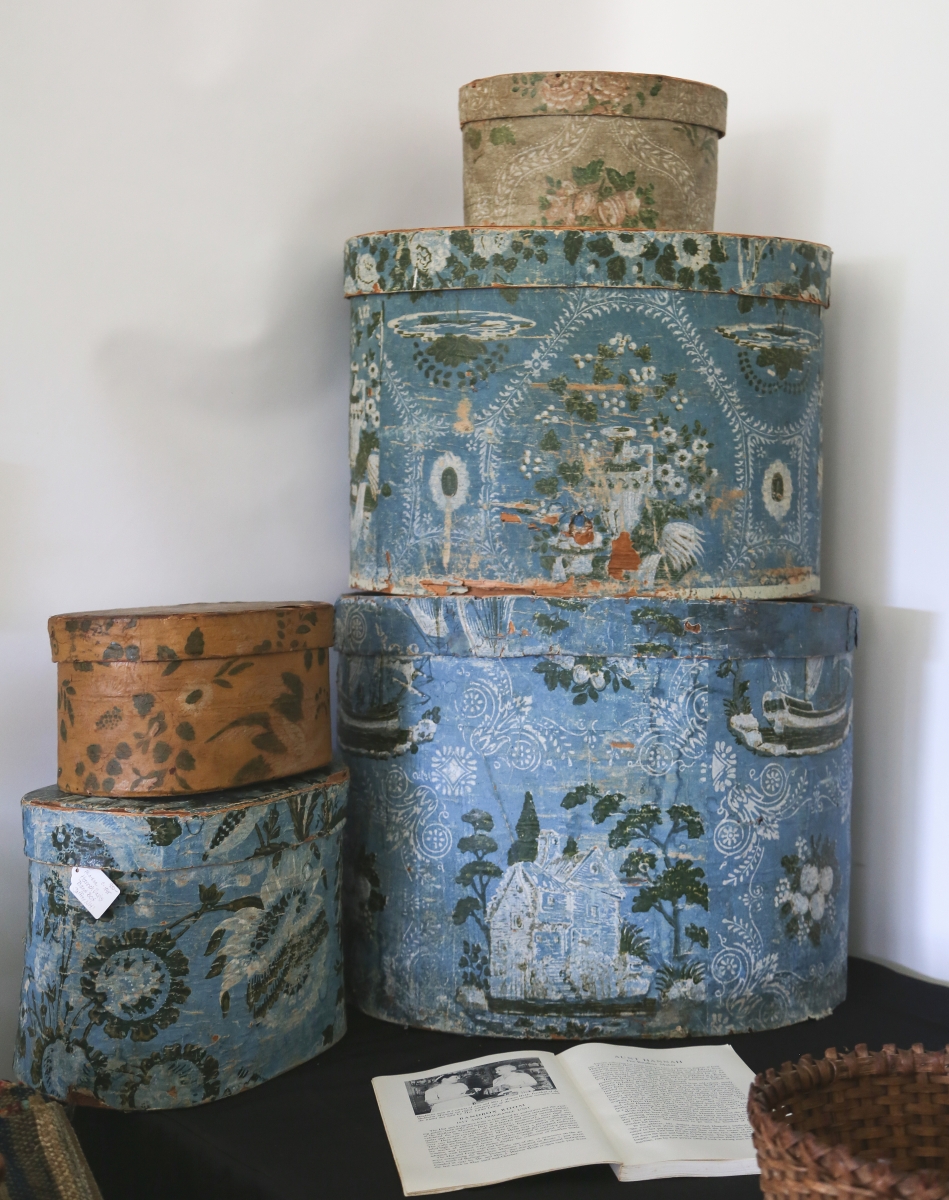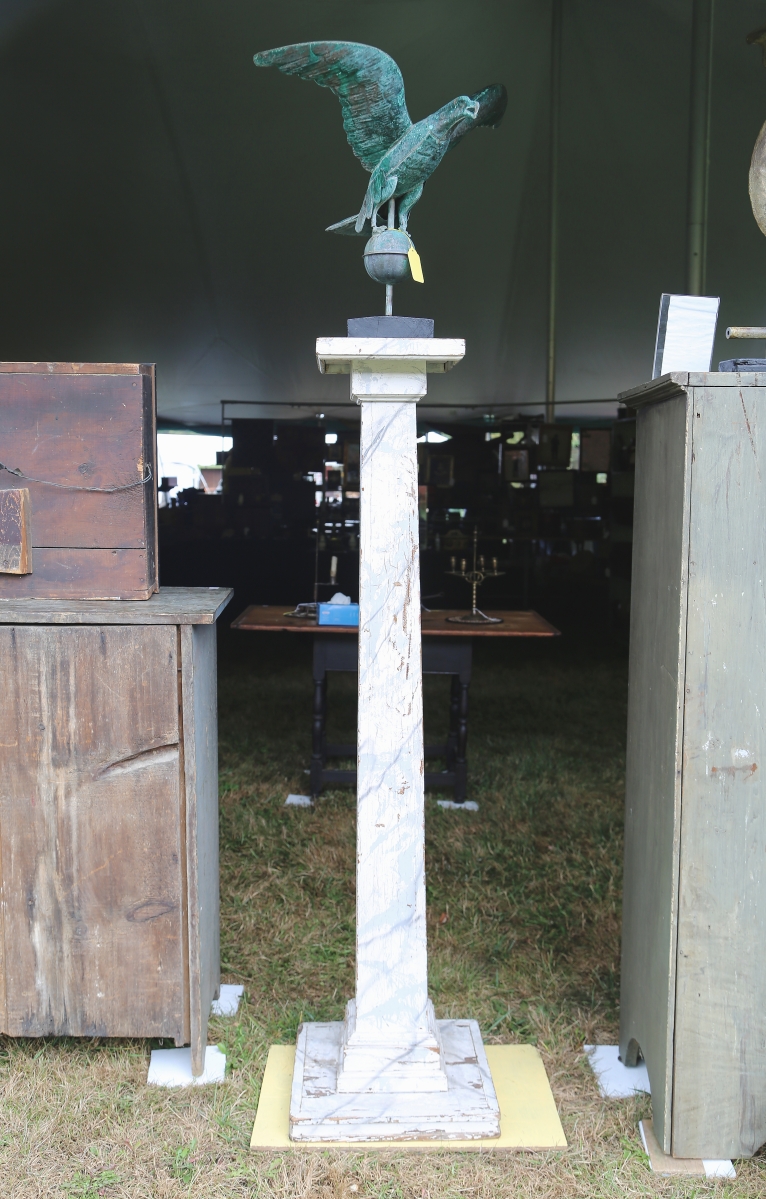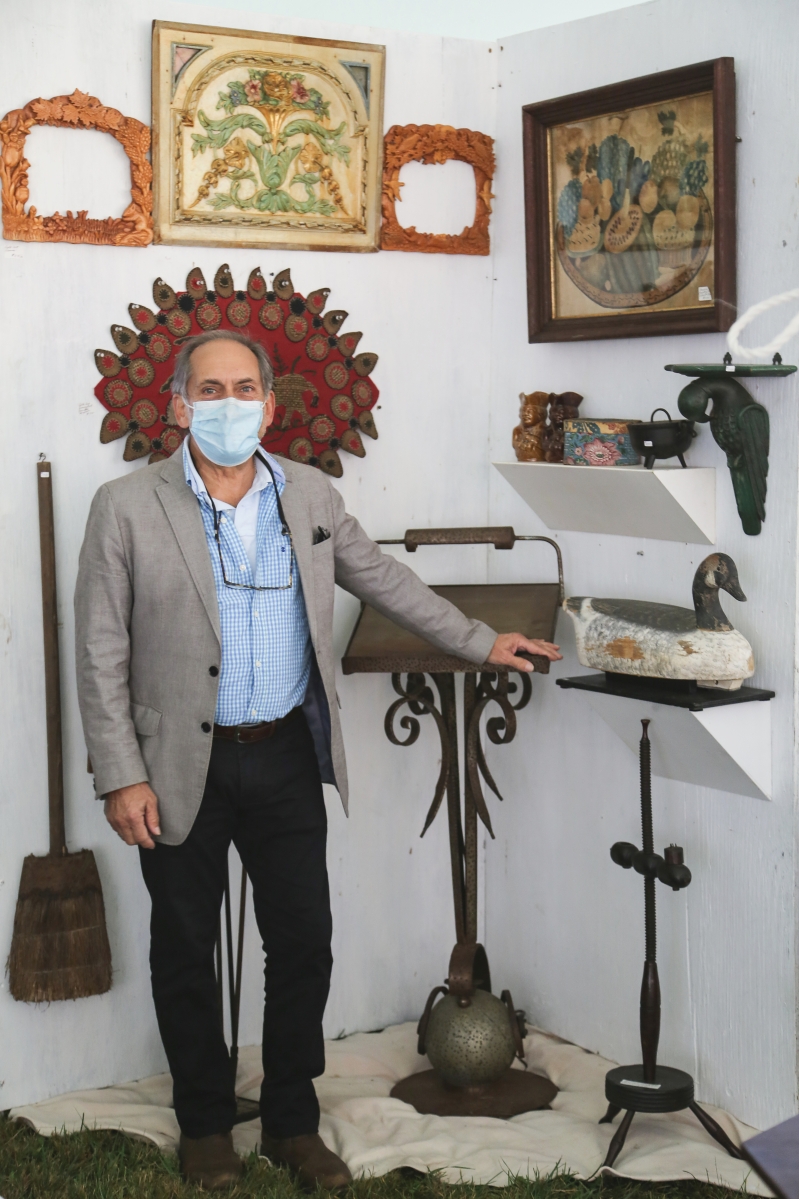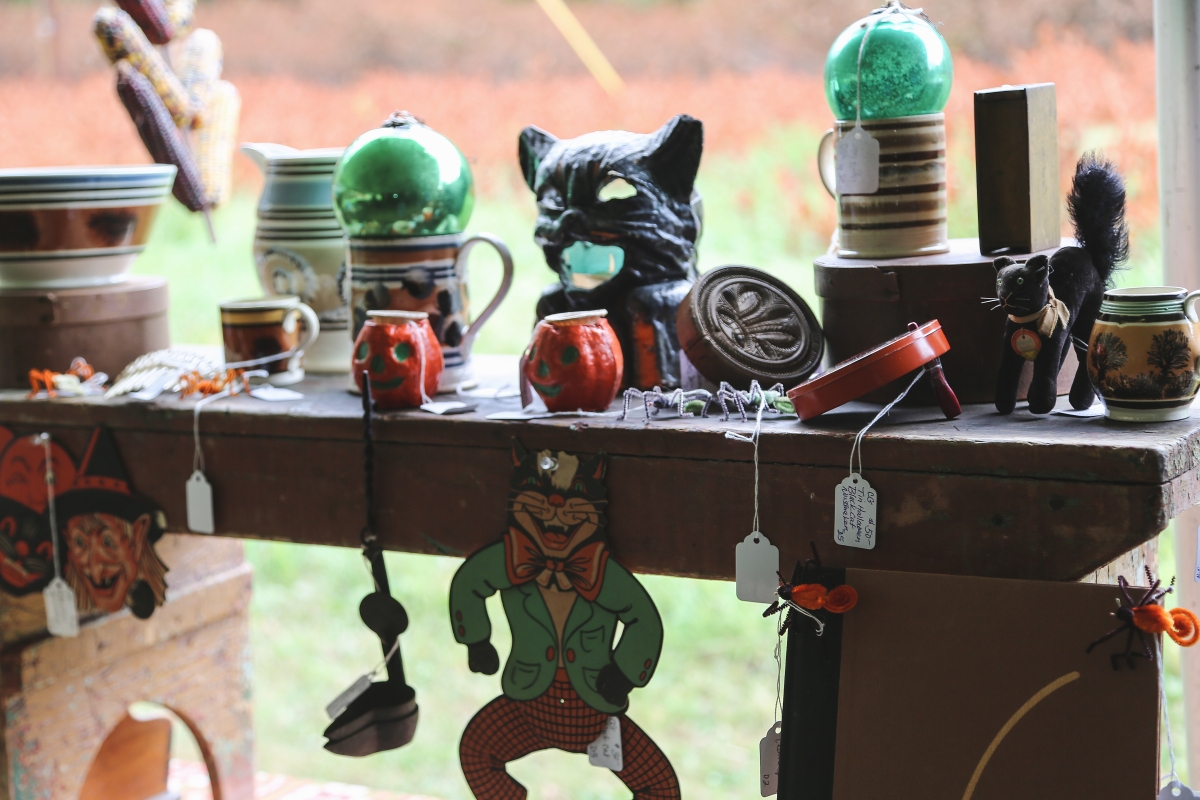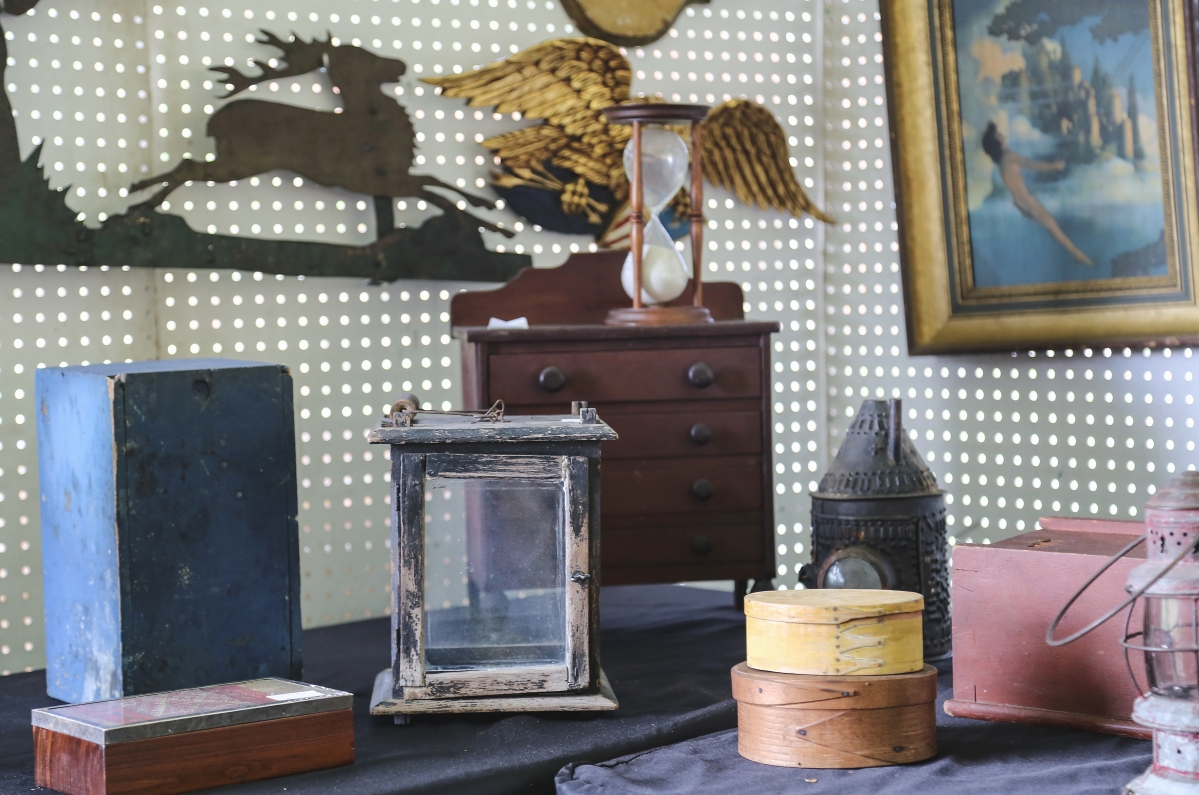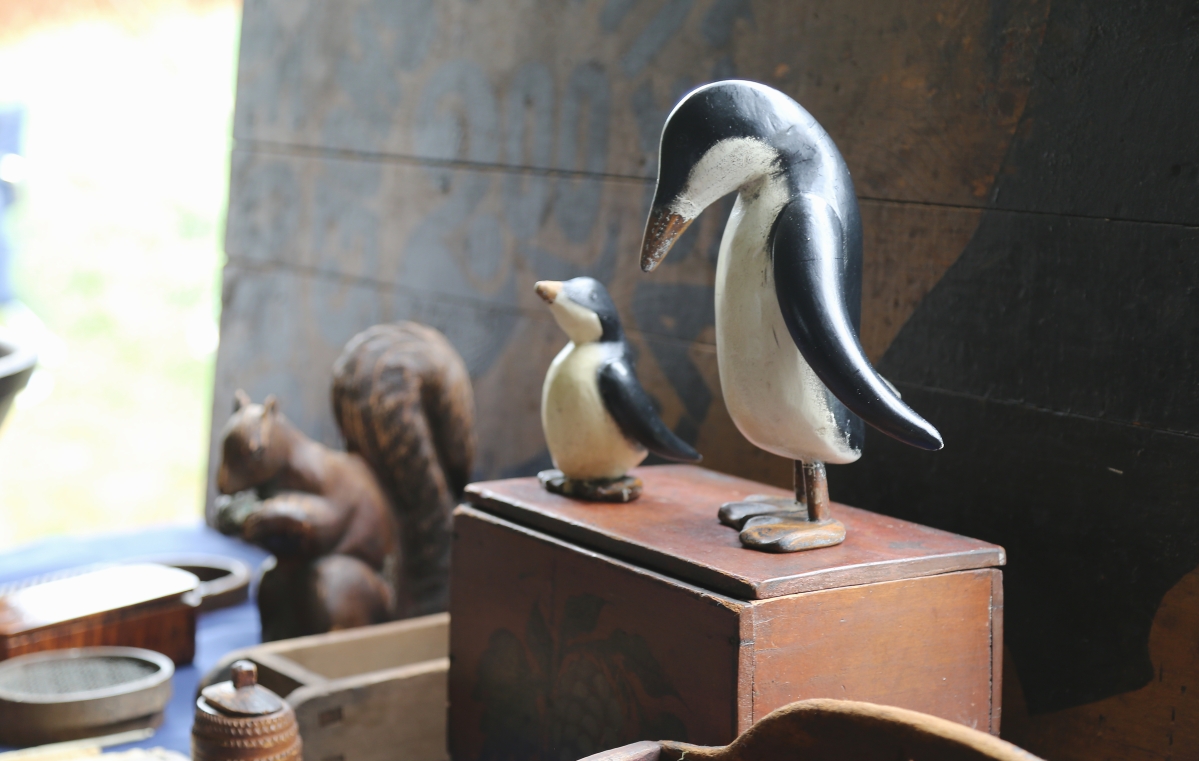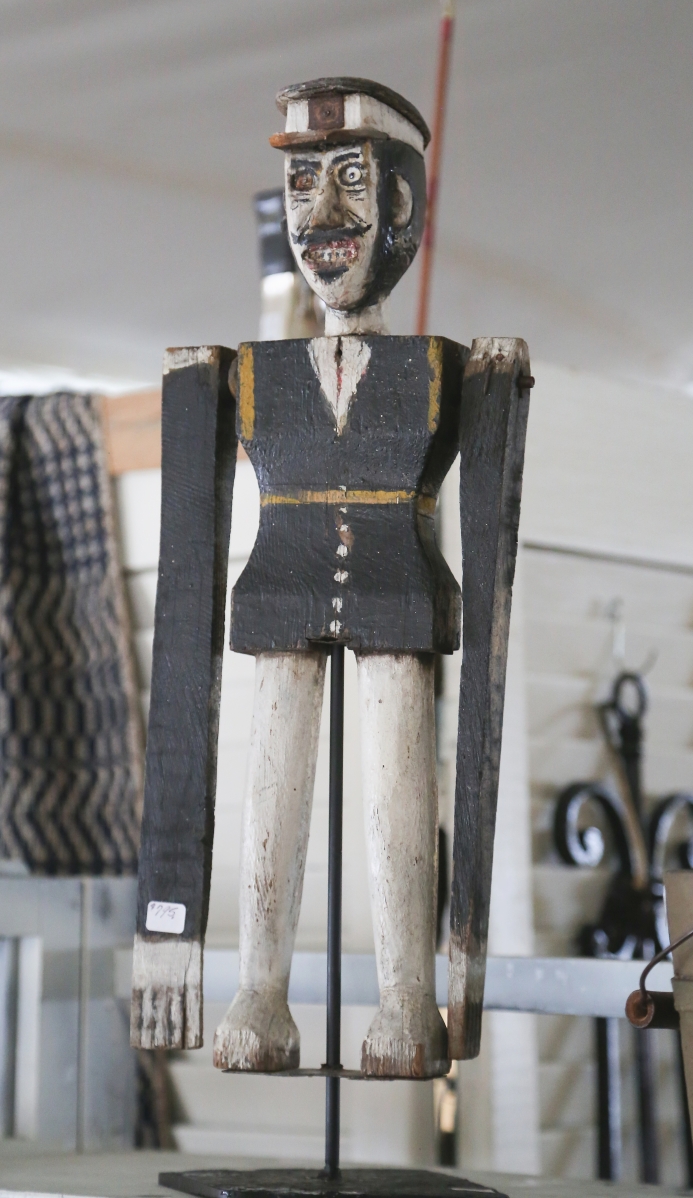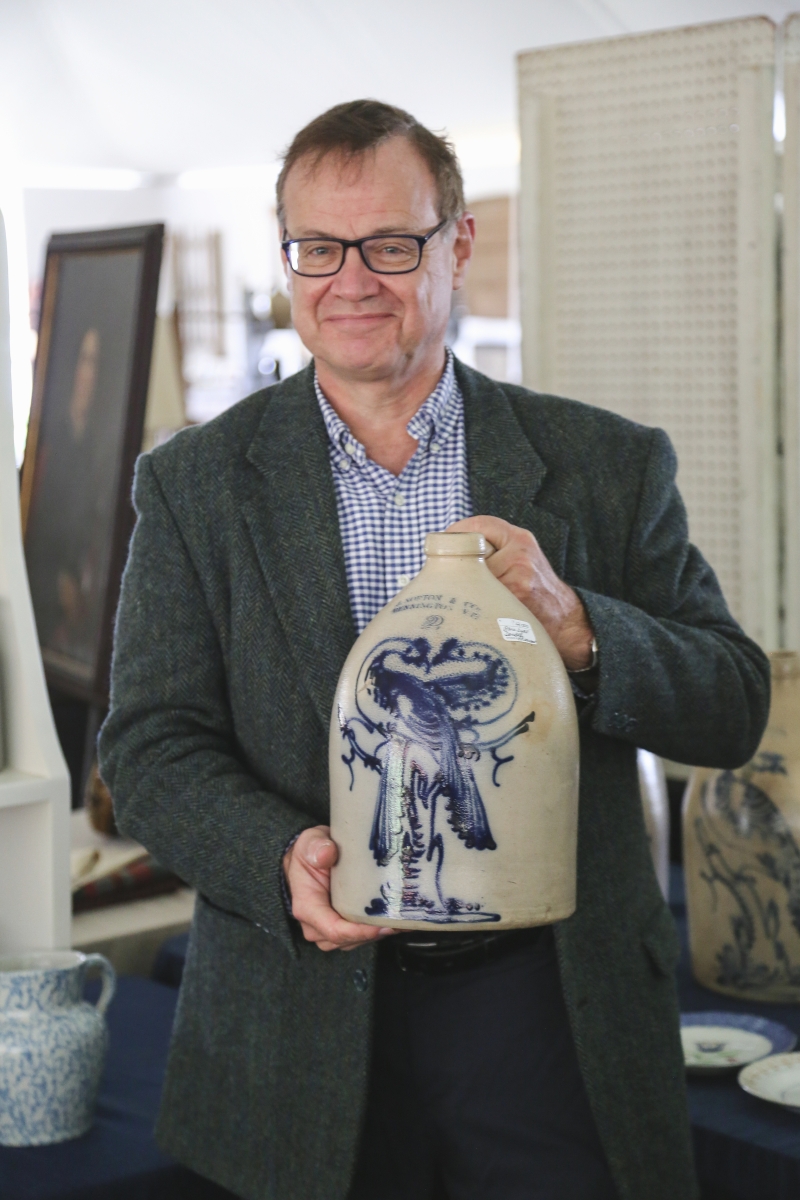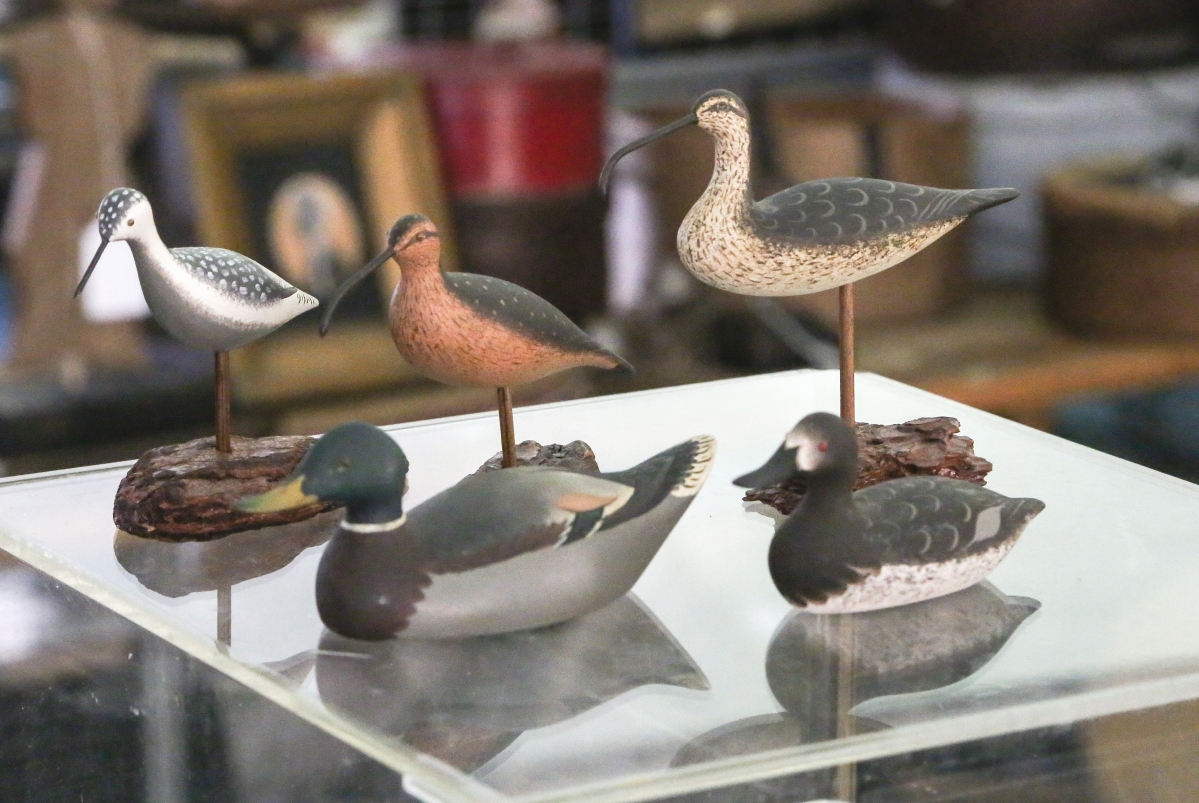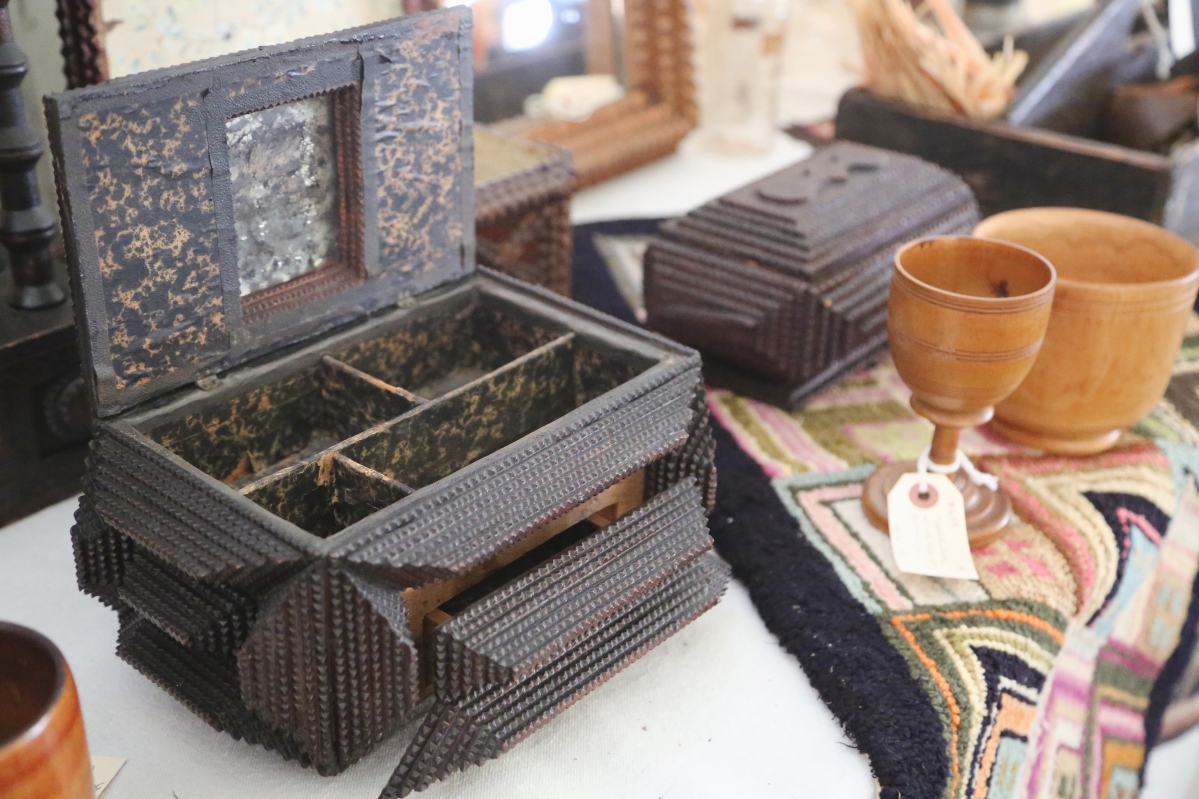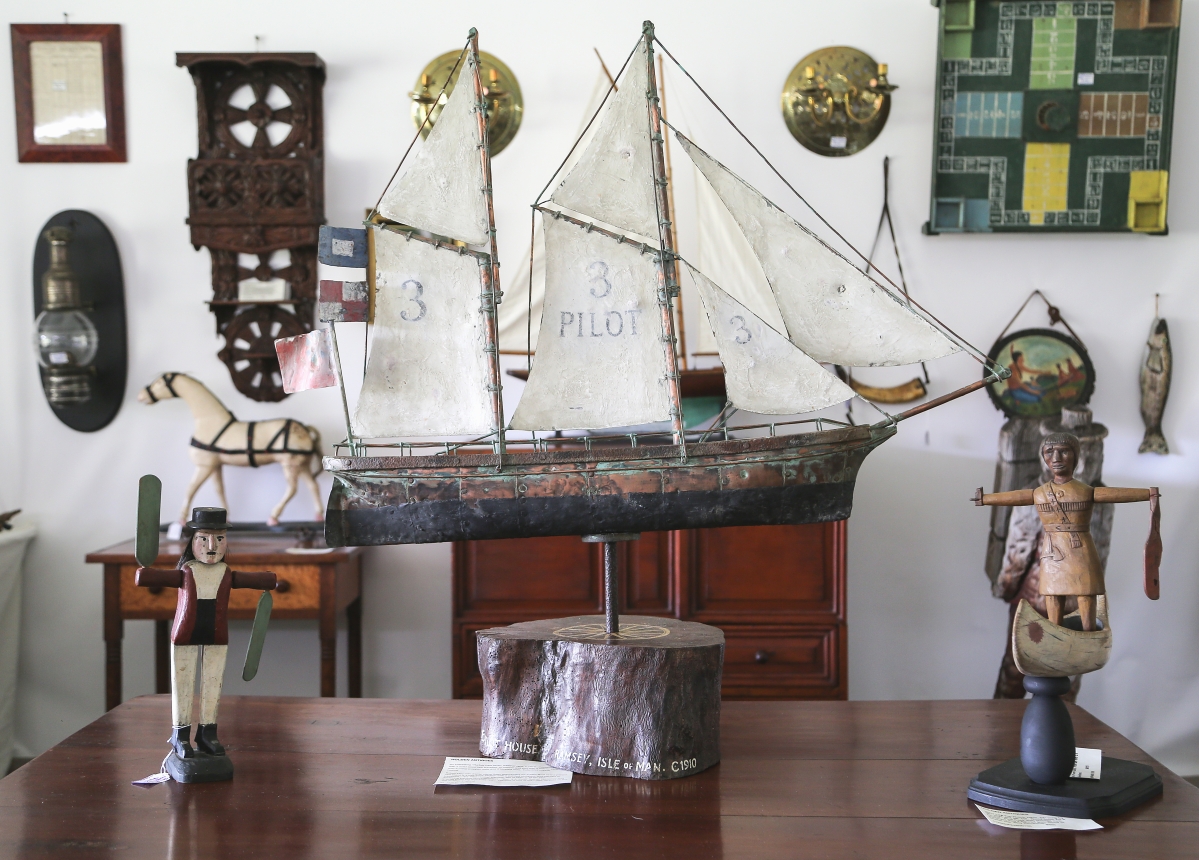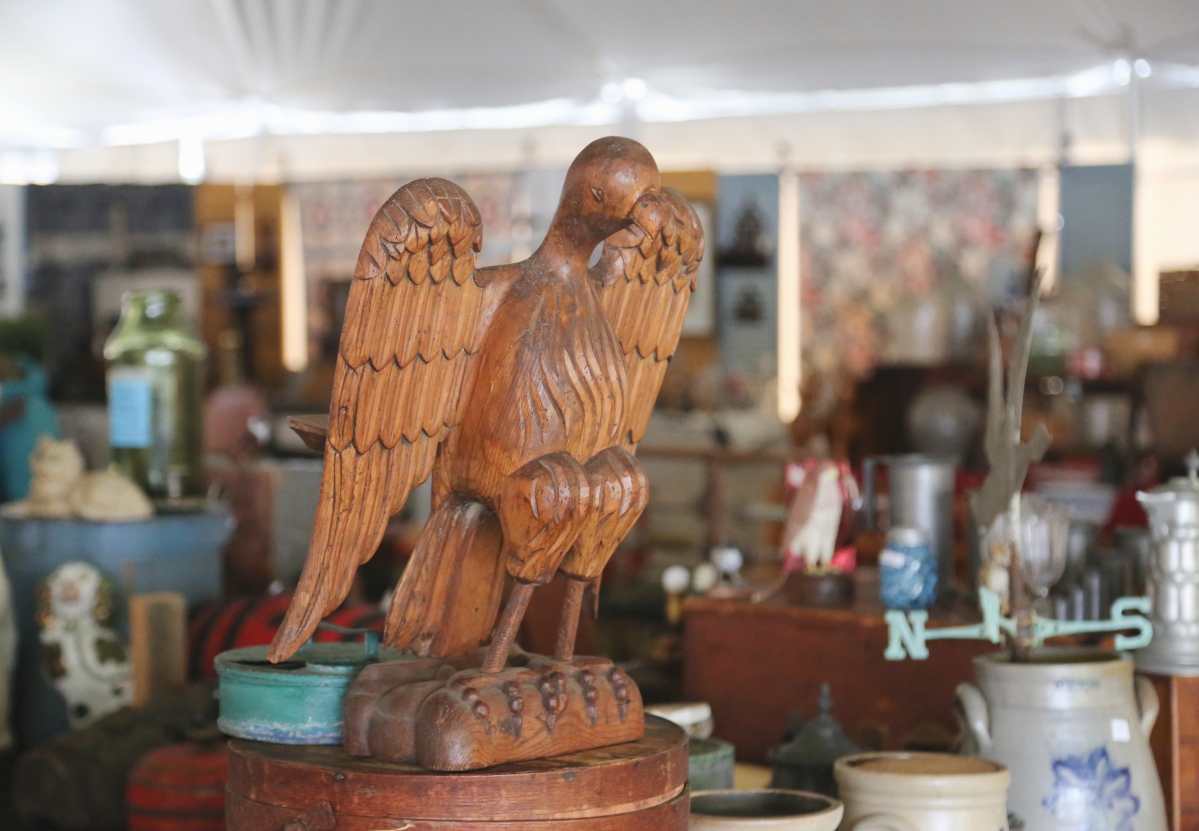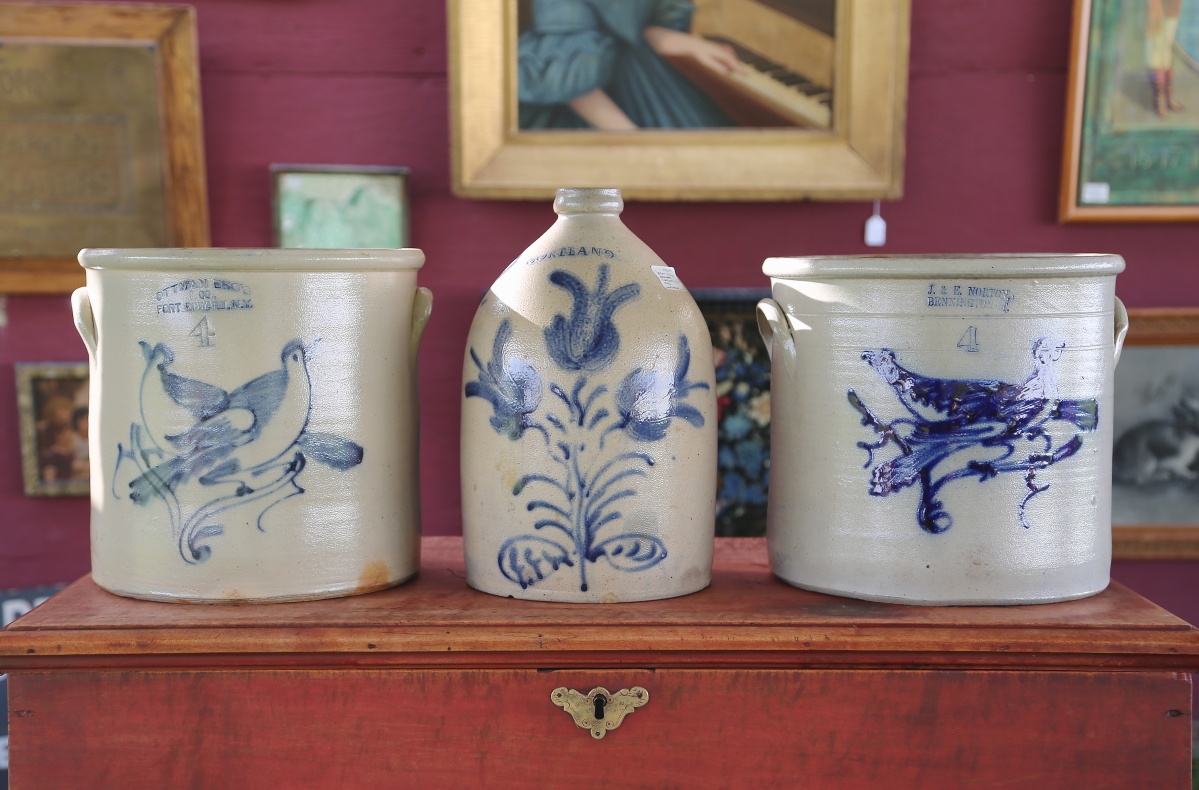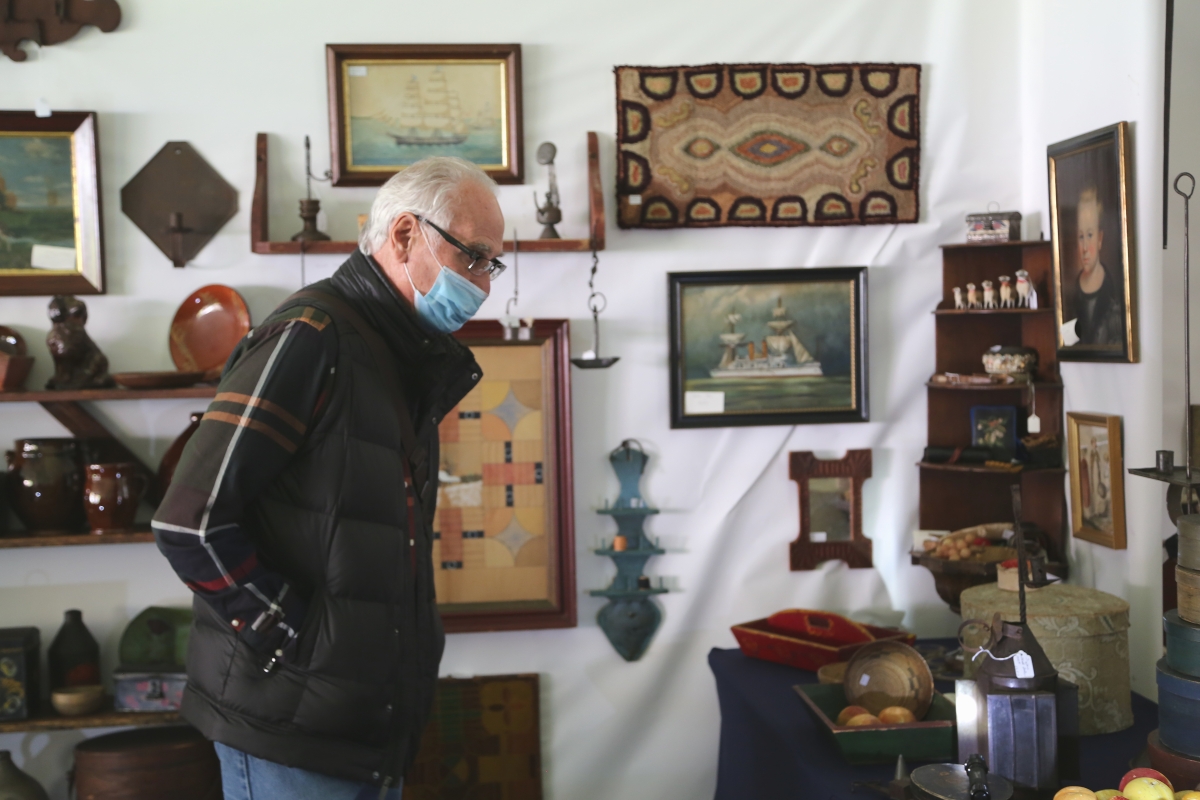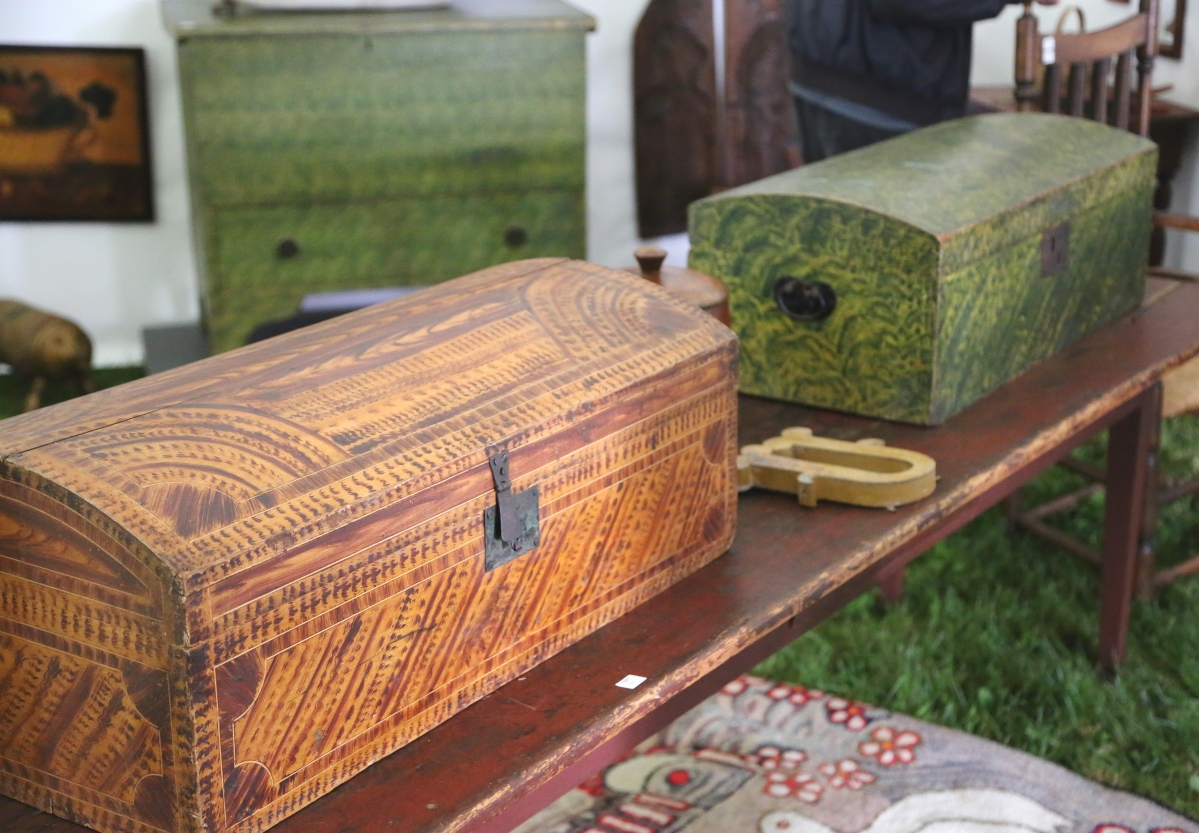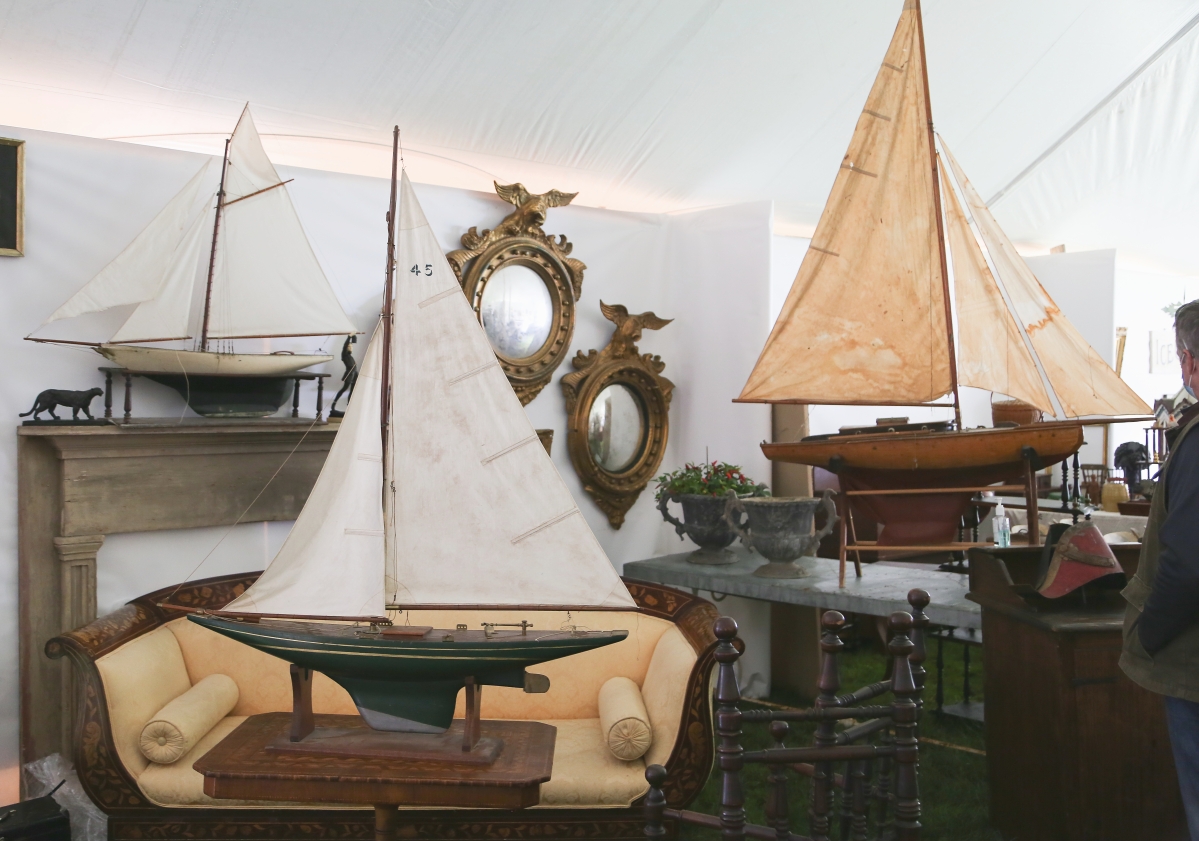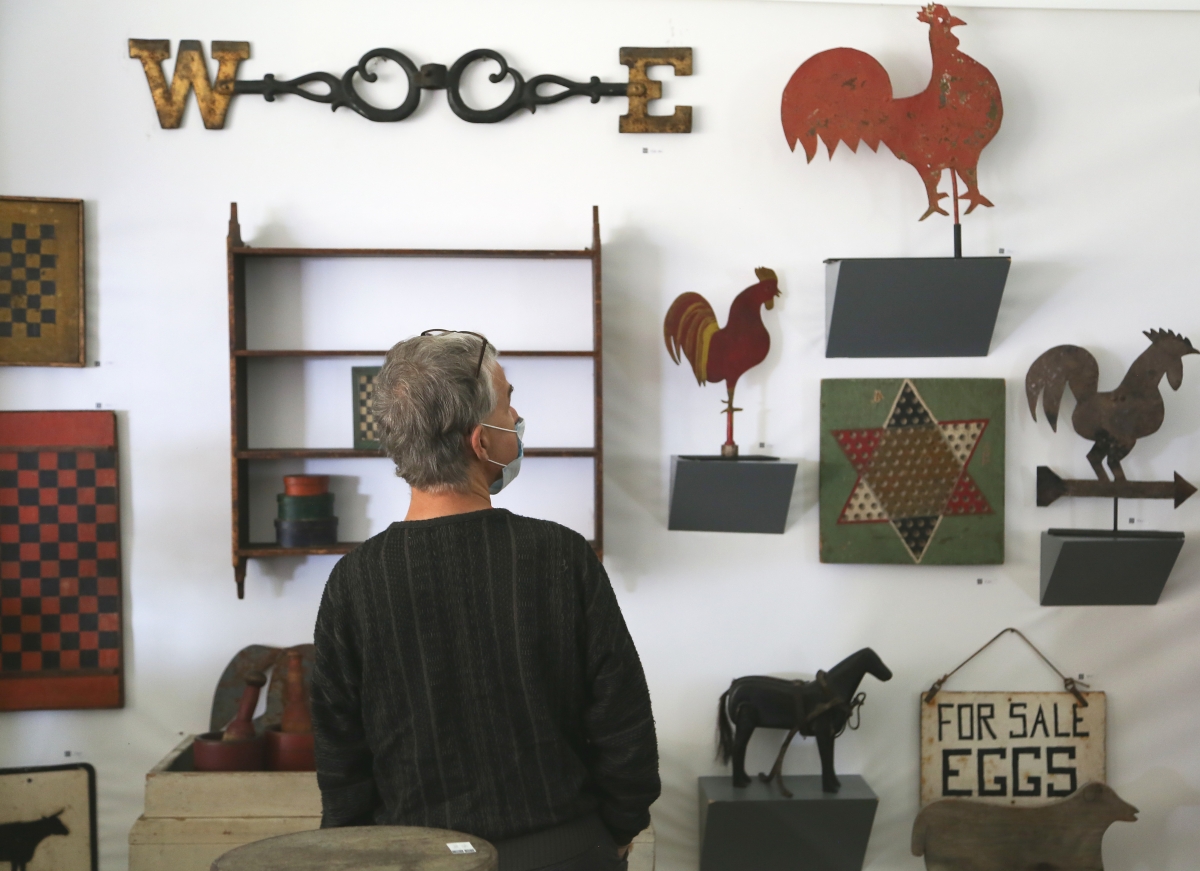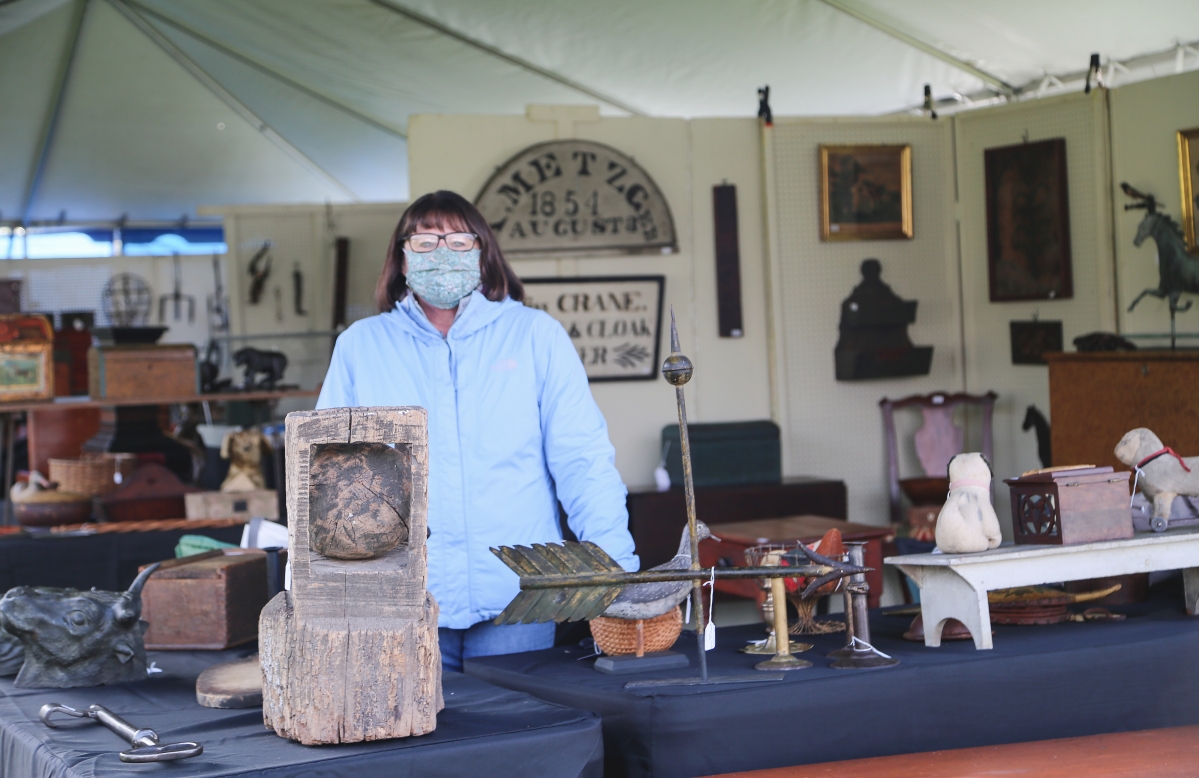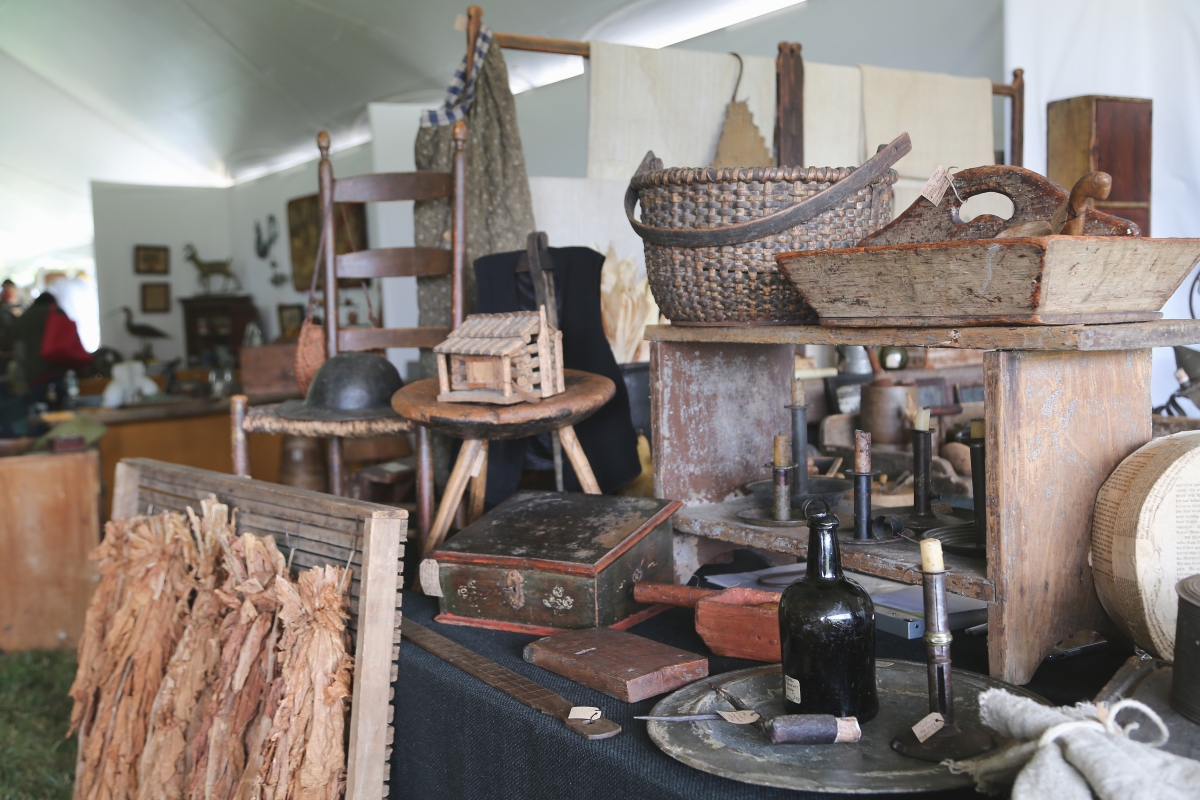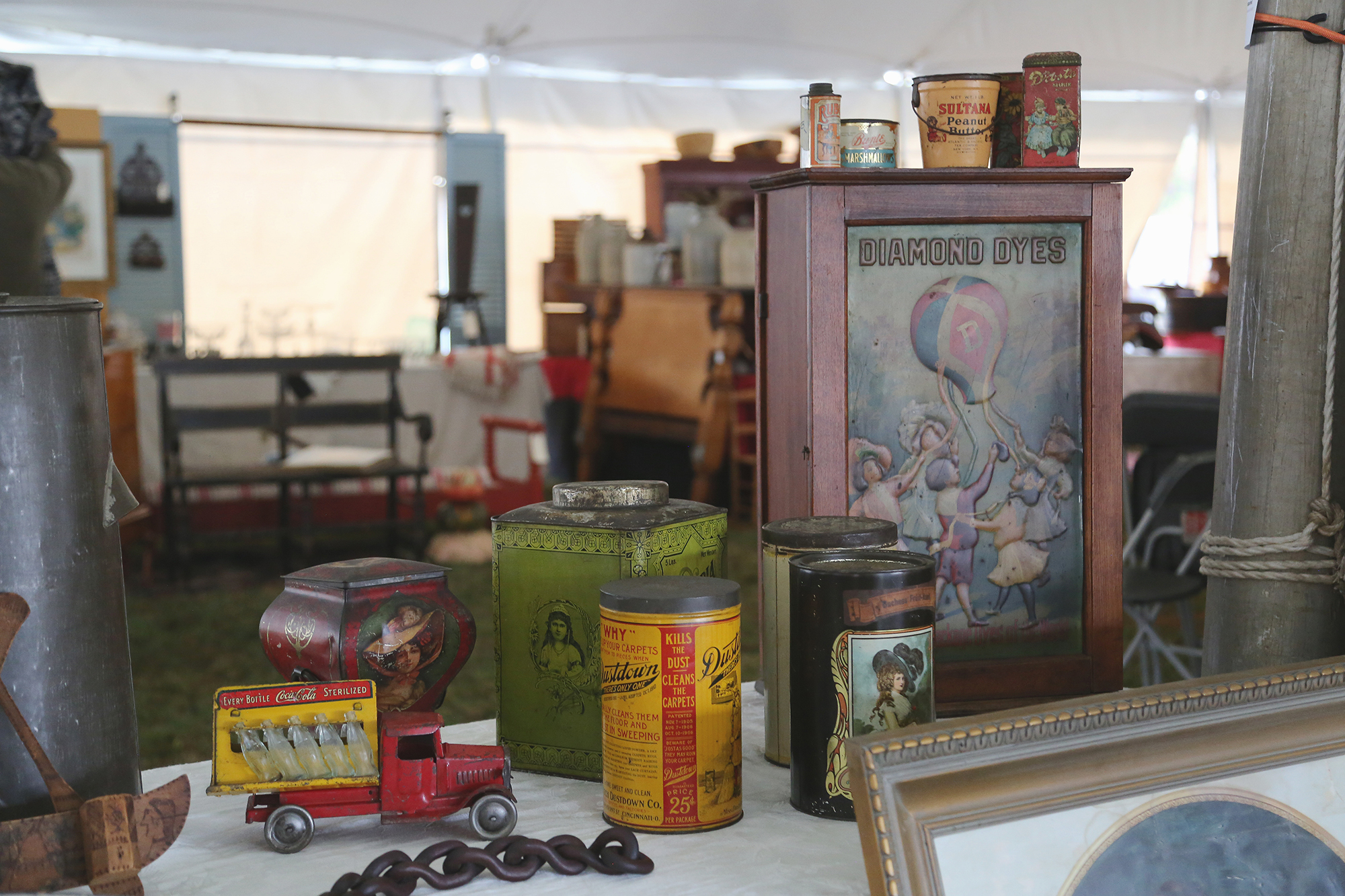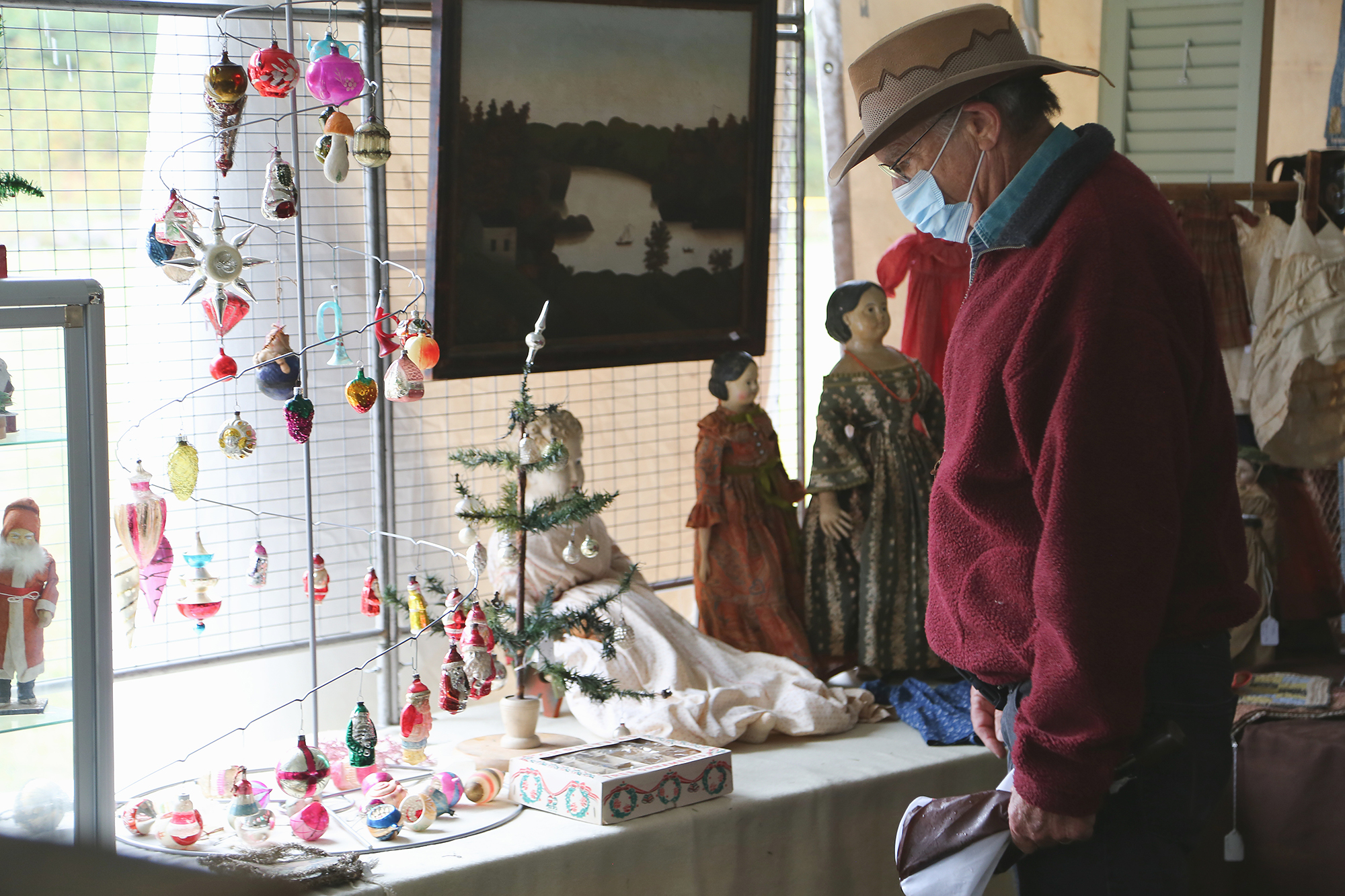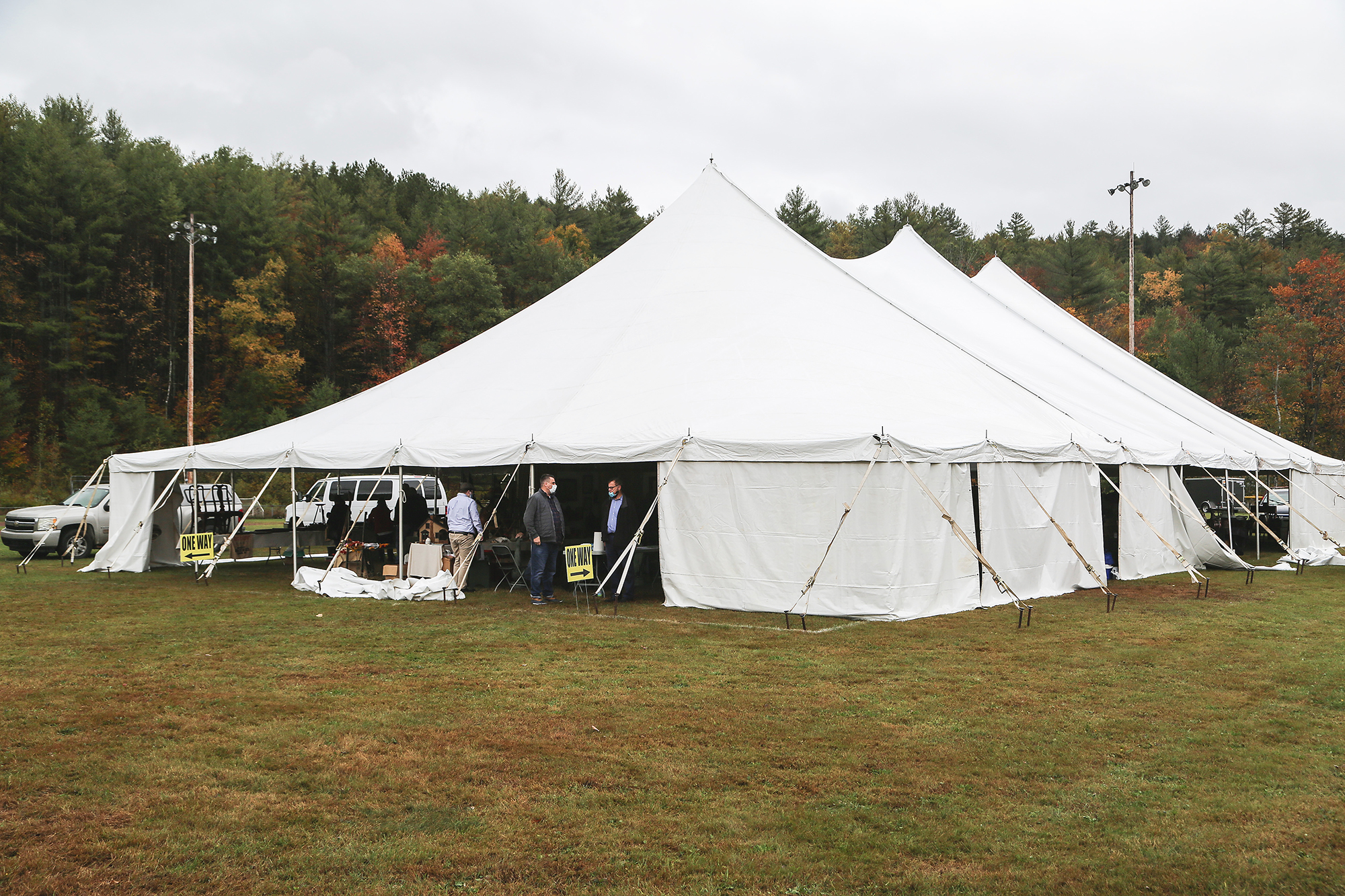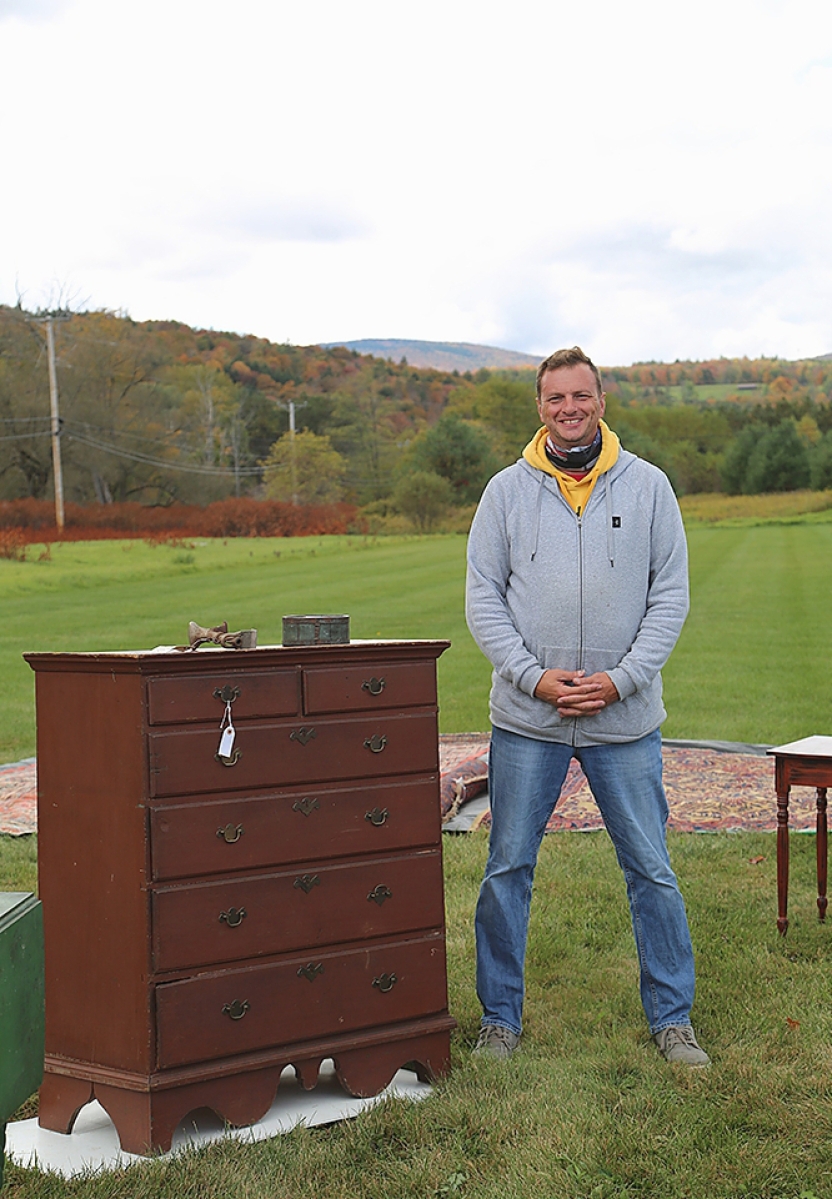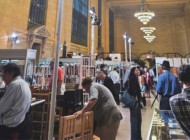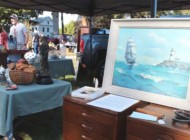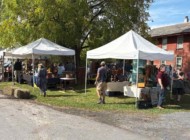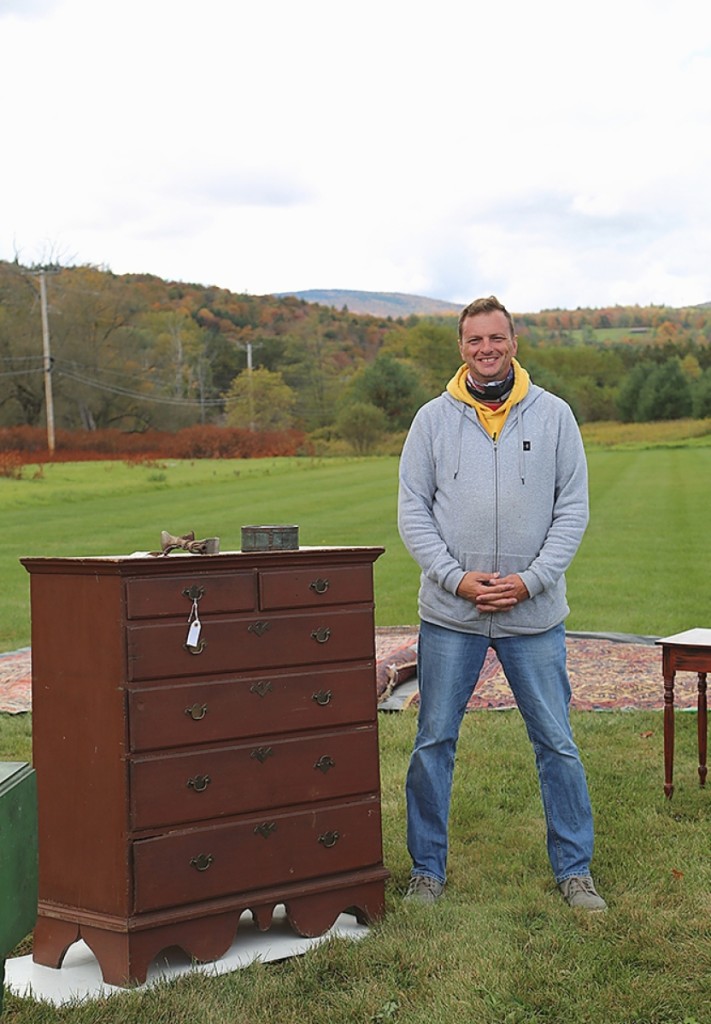
Show manager Steve Sherhag was commended by many for a successful and well-planned weekend of antiques en plein air.
Review and Photos by Greg Smith
LUDLOW, VT. – Leave it to Vermont, among the perennial homes of fresh air activity in New England, to salvage a vacant antiques show season and wrestle up some respite. Or better yet, perhaps due is more appropriately placed with show managers Steve and Bill Sherhag and the cohort of 80 dealers who braved the elements to stoke the fire of collecting over the weekend of October 2-4, their enthusiasm and energy framed by the exploding colors of fall foliage that spread across the rolling hills in the background.
Vermont Antiques Week endured this year with two of the normally scheduled five shows on hand – both were outside and under tents. And though you were unable to see the smiles on the attendees’ faces through the masks, the bags in their hands told the story well. Everyone was happy to see each other.
The Sherhags, who in normal circumstances organize three shows in Vermont Antiques Week, including the Black River Antique Show, Antiques in Vermont and the Okemo Antique Show, felt that the success of other recent outdoor shows could create a positive experience in the foothills of the Green Mountains.
The modified schedule saw the Black River Antique Show moved to the baseball field behind the Ludlow Community Center where about 20 dealers were on hand Friday and Saturday. Just down the road, Antiques at Fletcher Fields featured approximately 60 dealers on Saturday and Sunday. Most dealt principally in Americana and some had never done the Vermont shows before.
Black River Antique Show
Clouds slunk into the valley and dropped a light rain that fell off the sides of the three-pole tent as the show opened early Friday afternoon, but inside was a bustling scene of action as collectors ran around the small but sweet show and found a thing or two for themselves. Bill Sherhag manned the front table and greeted attendees.
A quick sale out of the gate was a pair of solid brass life-size seated whippets from Robert Conrad Antiques, Yeagertown, Penn., who has exhibited at a number of different Vermont shows over the years. The dealer said the whippets had come from the Pittsburgh area. Another sale came in the form of a turned burl bowl measuring 15 inches diameter.
“With how the world is, the show was certainly a bit of a challenge,” Conrad said. “But I really want to tip my hat to Steve and Bill for pulling it off. It went well and I had a fairly decent show all things considered. The crowds were on the light side compared to normal times, but everything went fine.”
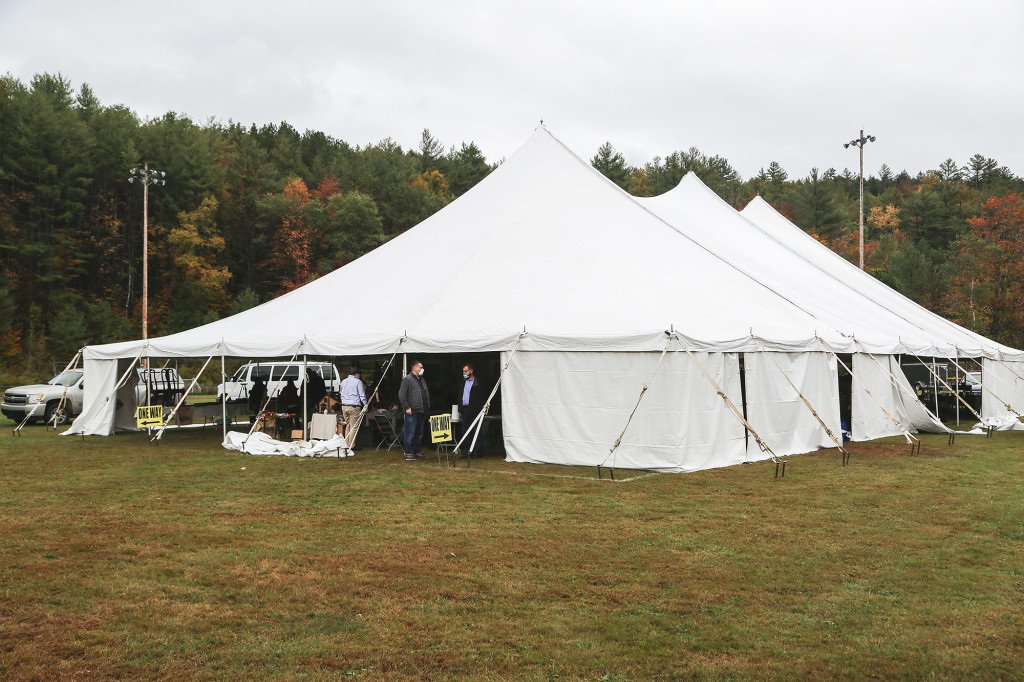
The tent at the Black River Antiques Show, held on the baseball field behind the Ludlow Community Center.
By The Falls Antiques, Painesville, Ohio, exhibited Americana, including two heavily carved sculptural pieces. Among them was a solid wood folk art Centennial waving flag in bright colors that the dealer found in New Hampshire, and the other was a polychromed carved architectural fragment with floral, pineapple and pomegranate motifs that may have been from a theatre.
Robin Stephens of Richmond, Mass., was offering a Nineteenth Century desk from Yale University with years of carved student graffiti in it. Also in the dealer’s booth was a recent find in the form of an oil on canvas portrait of a young Black girl signed by A.W. Wilgus and dated 1876. The young girl wears three rings, a bracelet and a dress off her shoulders while holding a small white dog. Stephens found the portrait in Rochester, N.Y.
Over at Blue Dog Antiques, Stafford Springs, Conn., dealer Judi Stellmach had luck selling from her collection of antique Christmas decorations. Among the red tags was a German Santa Claus sitting on a putz elephant. Stellmach said she enjoyed the show and bought well there.
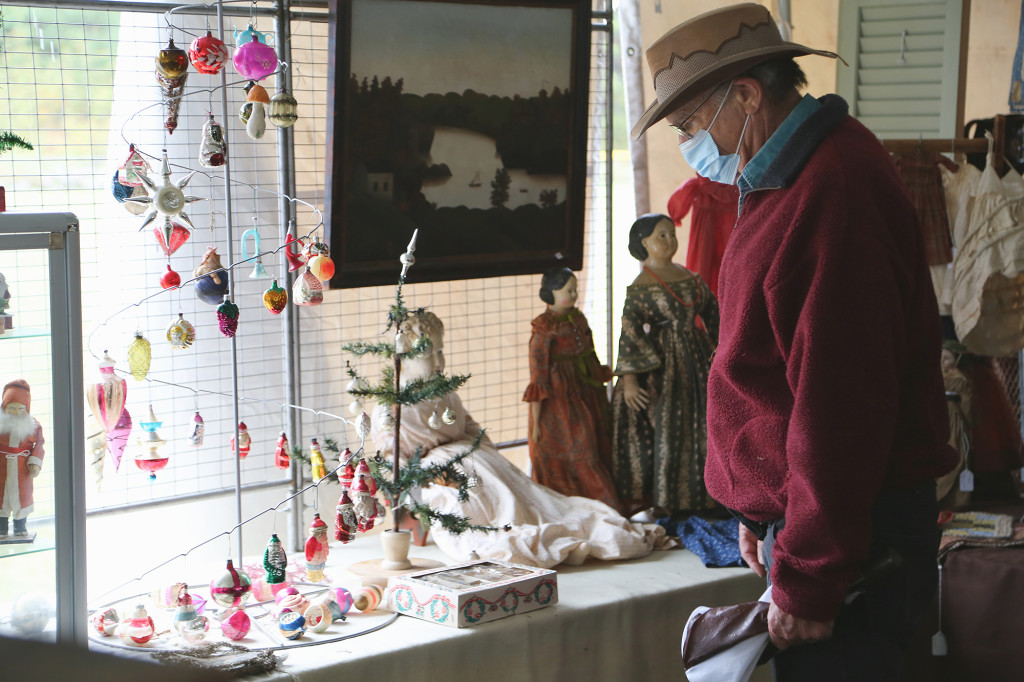
A buyer looks through the assortment of Christmas ornaments at Blue Dog Antiques, Stafford Springs, Conn. —Black River Antique Show
Christopher Nolan of Urbana Antiques, Farmington, N.Y., said he focused on bringing smaller things to the show. “I’ve brought my folk art collection,” he said as he motioned to two tramp art lidded boxes. “The carving is a little crude but that and the design of the box combine to make it great. They had knowledge of design, they were craftspeople.”
Christina Champion of Red Creek, N.Y., a first time exhibitor in Vermont, was excited to be showing off a treen bowl with red and blue paint from the second half of the Nineteenth Century. “The paint on it is so beautiful,” she said, “love it, love it. It looks like it’s hardly been used.”
A family of dealers behind Antiques at Wolfe Creek, Sugar Grove, Ill., were exhibiting a range of early primitives and Americana. Among them were two New England Brewster-style chairs from the 1700s and a double-stuffing sausage maker from the early 1800s in curly maple.
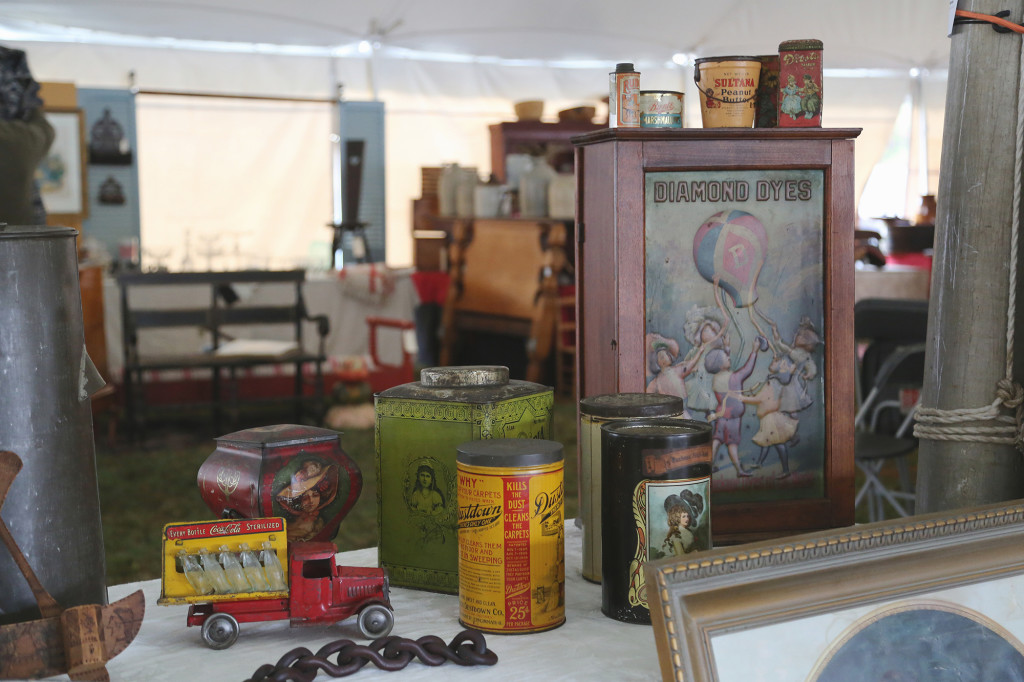
Painted tin in all its forms were on tap with Buy Old Stuff, Portersville, Penn. —Black River Antique Show
A carved wood eagle tabletop lectern was on show from Matt King, Marshfield, Mass. The dealer said it was circa 1920s by a folk artist. Also from the dealer was a pair of American Nineteenth Century andirons that rose up from the shaft into heart designs. “You don’t see period examples in that size,” King said, “I’ve had smaller ones but none that tall.”
Mendon, Vt., dealers John and Eileen Smart were on hand with an early 1850s carousel horse that they got from an estate in Pittsfield, Mass. It had original paint and pin construction, about 3½ feet high.
Around 3 pm that day the rain let up and the following day saw more traffic and better weather.
Antiques At Fletcher Field
An encampment of large tents and a picturesque autumn day greeted buyers to Antiques at Fletcher Field on its Saturday opening. Steve Sherhag related about 400 people passed through the gate early that day, an array of folks, including collectors, locals and young families eager to experience an antiques show.
Americana was again the course du jour. About 60 dealers were on tap selling everything from folk art, stoneware, primitives, treen, fine art, furniture and everything in between.
The closest tent to the gate housed three dealers – all from New York. Nancy and Gene Pratt, Victor, N.Y., were showing the largest captured ball carved whimsey the dealers had ever handled, measuring approximately 2 feet high. It was the first show the Pratts had done since February. Next to them was Jackie Spiegel with Spiegel & Associates, whose cupboard included a pewter communion cup from Albany, miniature duck carvings from Daniel Bruffee, Frank Finney and Charles Jobes and a large toy tole painted train car dated 1892. The final exhibitor in the New York tent was Ponzis Antiques, Trumansburg, N.Y. Among her favorite things, Connie Polce pointed to a tavern table with original black paint, a cut skirt and oil cloth painted game board top. “It’s very unusual,” Polce said, “you just don’t see them that often with the cloth.”
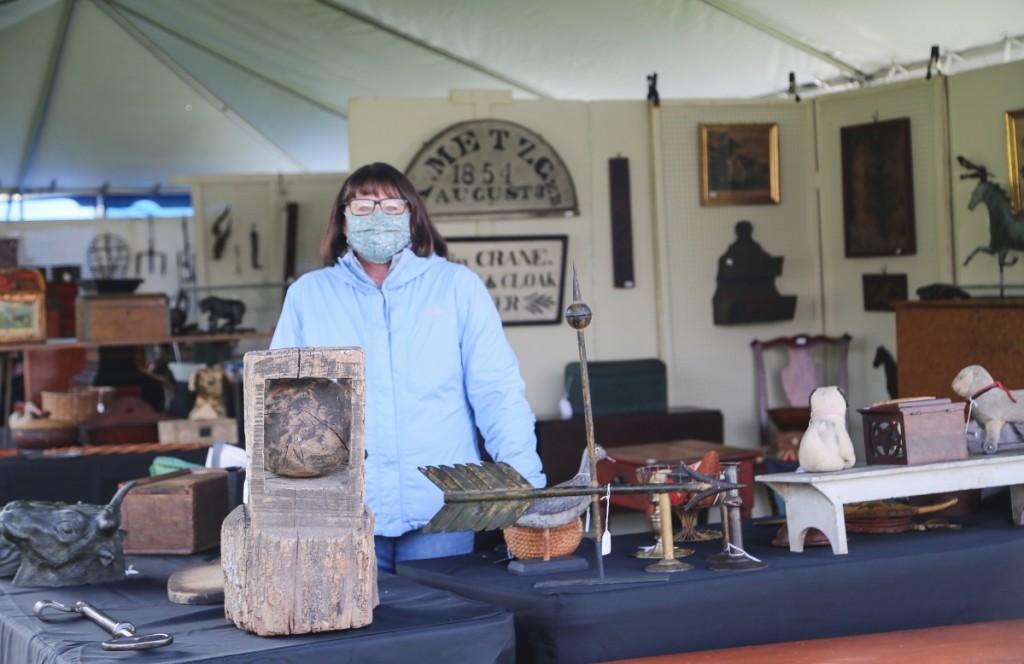
Nancy Pratt stands behind one of the largest captured ball whimsey’s the dealer has ever handled. Nancy & Gene Pratt, Victor, N.Y. —Antiques At Fletcher Fields
A Schoharie County blanket chest sat in the back of the booth at Greg Kramer & Co., Robesonia, Penn. “It’s probably among the top six examples with that bright color,” he said. The chest, from the second quarter of the Nineteenth Century, featured provenance to dealer Peter Tillou. The central decoration featured an urn with a vibrant bouquet of flowers and a foliate border running along the top and bottom of the frontispiece.
Three pieces of cobalt decorated stoneware sat atop a chest in the booth of Dan and Karen Olson, Newburgh, N.Y. “They all have big decorations,” Dan said, pointing towards the center piece, a Cortland jug from New York. “I’ve never seen tulips covering the front like that,” he said, “big, heavy and blue.” Flanking it were two 4-gallon crocks, one featuring two overlapping birds from Ottman Bros. & Co, Fort Edward N.Y., and the other from Bennington, Vt., potters J&E Norton.
The Village Braider, Plymouth, Mass., brought along garden statuary, paintings, sculpture and furniture. The latter produced seven sales, including a red painted stepback cupboard, a tiger maple tea table and pie safe with punched tin panels. Dealer Bruce Emond featured a forged iron blacksmithing swage block with enough dynamic that it functioned as a sculpture. Emond said he remembers originally happening upon the block when it was among a series of swages shown at the Winter Show decades ago by dealer Gerald Kornblau. Emond said he liked it not only for its sculptural style, but because it reminded him of his youth when he watched his grandfather, an immigrant from Italy, fashion all sorts of things from iron. “I remember my grandfather had a giant bellows in his blacksmithing shop in West Quincy,” Emond said. “He made beautiful things back in the ’60s. It was always in my blood.”
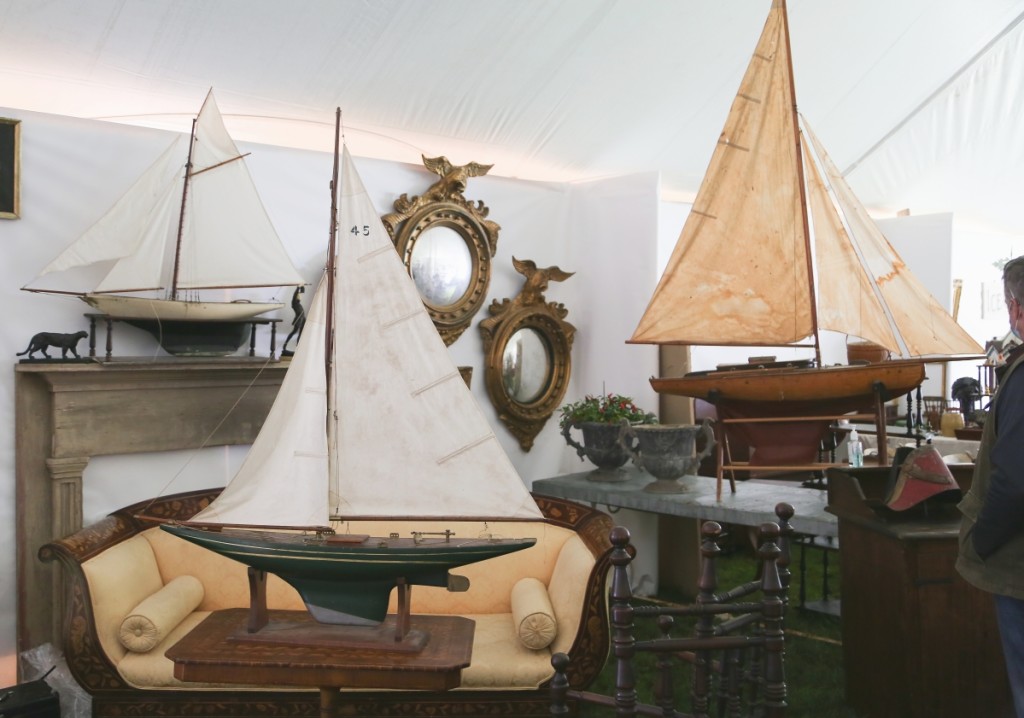
From the Saugerties Antiques Center, Saugerties, N.Y., were these three pond boats that hailed from one collection. The largest example on the right was Dutch while the two on the left were American. —Antiques At Fletcher Fields
A fun child’s rocking sheep was set out front of the booth of Tom Clark, Francistown, N.H. “People like sheep,” Clark said on bringing the form into the house. It had long fabric horns, a wool coat and a kind disposition. His wife, Anne Behrsing, was on hand offering a selection of her bench-made art jewelry.
In Vermont-related offerings, dealer Robert Weston was showing matching portraits of husband and wife F.K. and Eliza Haven of Vergennes, Vt. Dealer Jim Dickerson had sold them at the Hartford Show in the 1990s and reportedly acquired them from the descendants of the sitters. Haven was a hardware merchant and partner in the business Strong and Haven, with Foster C. Strong. The dealer notes that the works were likely painted by artist Benjamin Franklin Mason, an itinerant painter described in the 1872 New England Historical and Genealogical Register as a “favorite artist in Vermont.”
A South Shaftsbury, Vt., blanket chest was in the booth of Dennis Raleigh Antiques and Pumpkin Patch Antiques, Searsport, Maine. Raleigh attributed it to maker/decorator Thomas Madison based on the painting style. The dealer also had a dated 1840 mourning portrait with symbolism that suggest the sitter’s husband who passed away was likely a captain or sailor.
Hilary and Paulette Nolan, Falmouth, Mass., were excited to offer a New Hampshire oval top tavern table in original green paint. Hilary said it dated to around 1770. From closer to the coastline was a Connecticut or Rhode Island blanket chest in pine with original ogee bracket base.
The circa 1840 Connecticut blanket chest featured on the cover of this issue belonged to Kensington, Conn., dealer Derik Pulito, who said the applied band molding along the edges was something he had never seen before. The dealer also featured a blacksmith trade sign for C.F. Keast who advertised both “horseshoeing” and “general jobbing.”
Newcastle, Maine, dealers Jewett-Berdan Antiques featured an array of folk art and painted Americana smalls. Among their offerings was a red, white and blue pagoda with cutout panels and the date 1909 fashioned into its stairway railing. On the back wall was an ice fishing pole from Michigan in the form of a pike with all-over spackled paint decoration and completely intact.
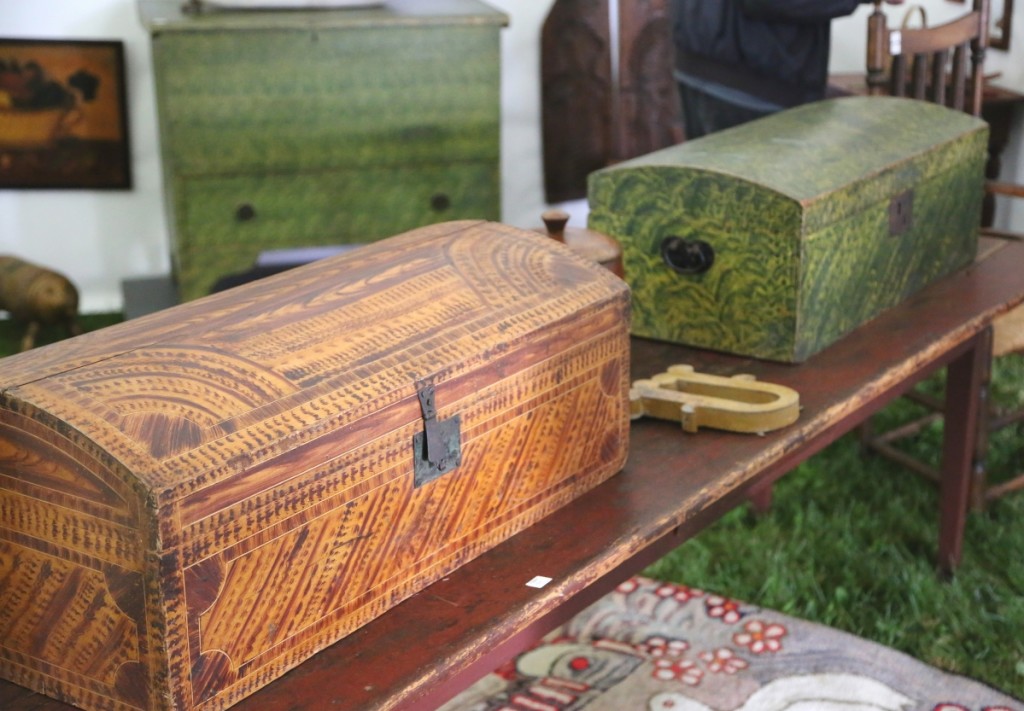
Pick a color. The brown/gold example seen left is a Shaftsbury, Vt., work from Thomas Madison while the example painted green seen right is from New Hampshire. Stephen-Douglas Antiques, Rockingham, Vt., and Walpole, N.H. —Antiques At Fletcher Fields
“The show turned out very well for us,” said local dealer Stephen Corrigan of Stephen-Douglas Antiques, Rockingham, Vt. “We started off slowly but I had a big day Sunday. I was very pleased, it was nice to get out and be with people and see nice stuff. The quality at the show was wonderful, there was a lot of interest in there. I was so happy that Steve was able to save the show and the event this year, that was special.”
Corrigan also had an open house that weekend at his gallery nearby in Walpole, N.H., which he said produced good traffic and more sales. Both the Windham Antique Center in Bellows Falls, Vt., and Flying Pig Antiques in Westmoreland, N.H., had open houses as well.
Wallpaper bandboxes by early Nineteenth Century New Hampshire maker Hannah Davis were on tap with Kris Casucci of Walker Homestead, Brookfield, Mass. “Hers are my specialty,” Casucci related. “They’re wooden to begin with, she was probably a leader in that as she invented a machine to cut the boxes.” Davis’ father died earlier on in her lifetime and she was unmarried at the age of 34 when her mother died, leaving her to figure out a way forward. “Her best customers, she had found, were the young women and teenage girls who had by 1825-30 begun working in the enormous textile factories in the nearby Merrimack River cities of Lowell, Nashua and Manchester,” wrote Lilian Baker Carlisle in Hat Boxes and Bandboxes at Shelburne Museum. “During the factory lunch hour she parked the vehicle outside the gates and soon it was swarming with young girls eager to purchase a brand new bandbox.”
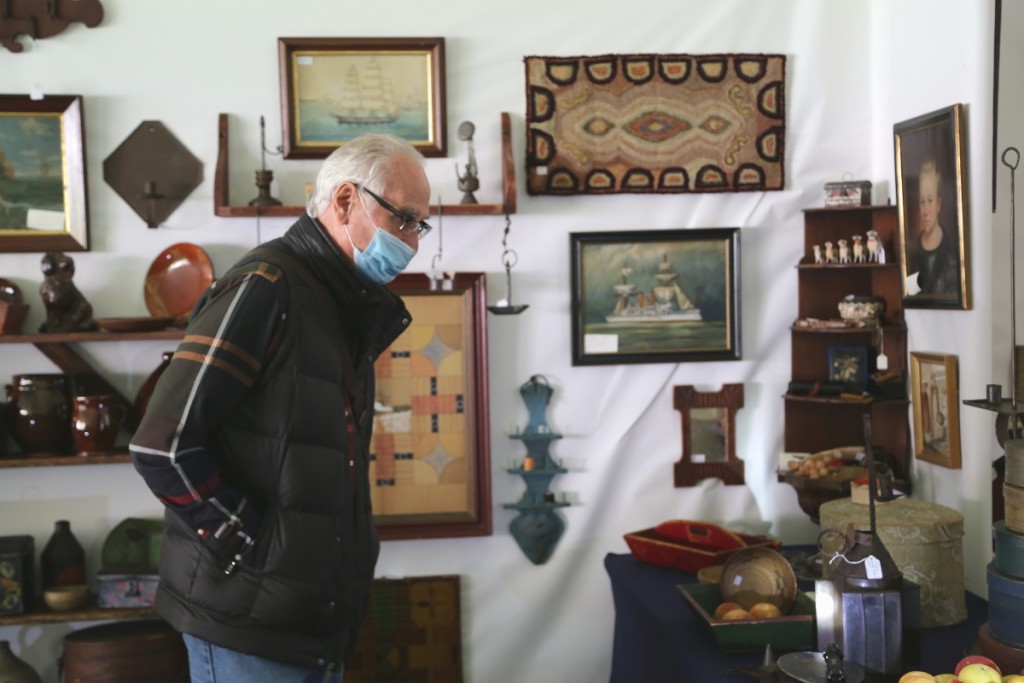
Dealer Rich Garthoeffner was not selling, but he was caught perusing the show as a buyer. —Antiques At Fletcher Fields
Shortly after opening, Helen and Larry Bryan of H&L Antiques, Princeton, N.J., had sold a circa 1840s stepback cupboard with a plate rack and full mortise door on original hinges. On the opposite end of the booth was a slat-back armchair circa 1720 with turned heavy posts rising to ball and vase finials.
The Sherhags were presented with game time obstacles at each of the two shows. Saplings were cut down and a road was improvised for dealers to load in and out at the Black River show after the school in the adjoining lot refused to allow entry on a shared road. On Fletcher Fields, the foundation that had donated the parcel to the town protested the show’s use of the field and a Fire Marshall was called onto site during set up. The dealers at Fletcher Fields were then unable to drive a van onto the grass and packed in and out from their vehicles in the nearby parking lot.
“I’m happy it’s over,” Steve Sherhag said with a laugh the next week. “But I think it went well. For anything that was under my control, we handled it well. The logistics this year, the way things are with Covid, just being able to pull off a show is a miracle.”
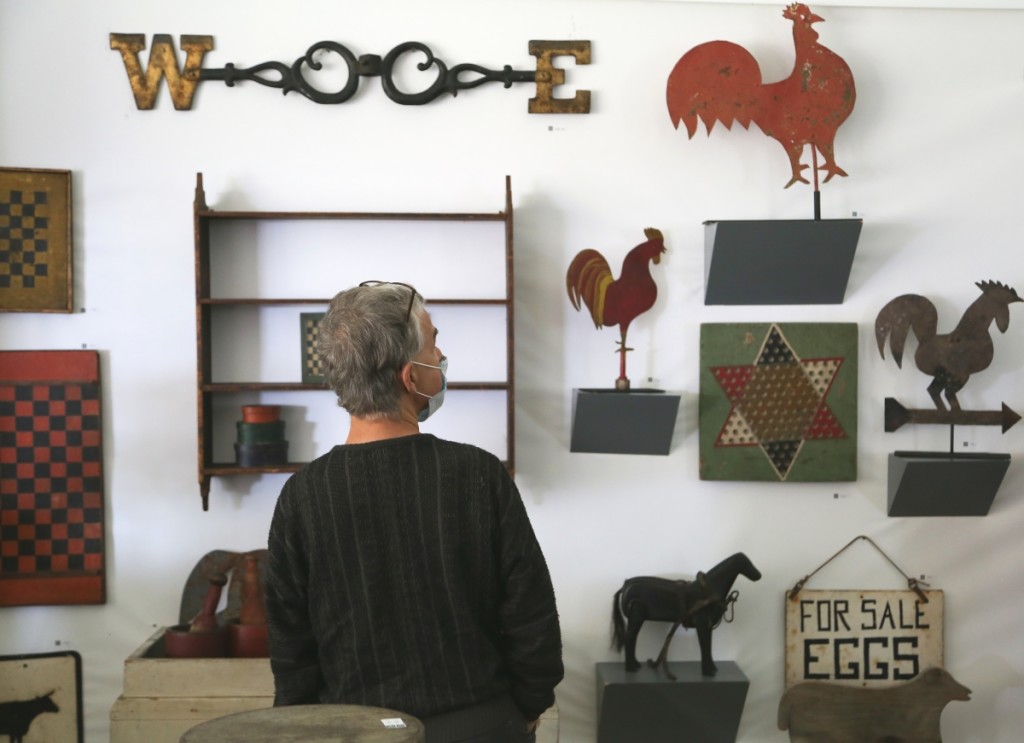
A buyer checks out the offerings in the booth of Missouri Plain Folk, Sikeston, Mo. —Antiques At Fletcher Fields
On the quality of the show, nearly everyone agreed that this was no flea market – the material was honest and good. “I think dealers did an admirable job in bringing good material,” Sherhag said. “I just mean good things all around. That made me happy, we got a lot of good feedback on the quality.”
Dealer after dealer we spoke with mentioned that they were happy to get out and go to an event that was run properly. Everyone “masked up” and were happy to do so, if only for the opportunity to feel normal and be around beautiful things.
Sherhag related that next year’s event may look similar. “It’s good to have continuation,” he said. “Promoters have to get creative in the next year, we’re not out of the woods yet.”
For additional information, www.vermontantiquesweek.com.

